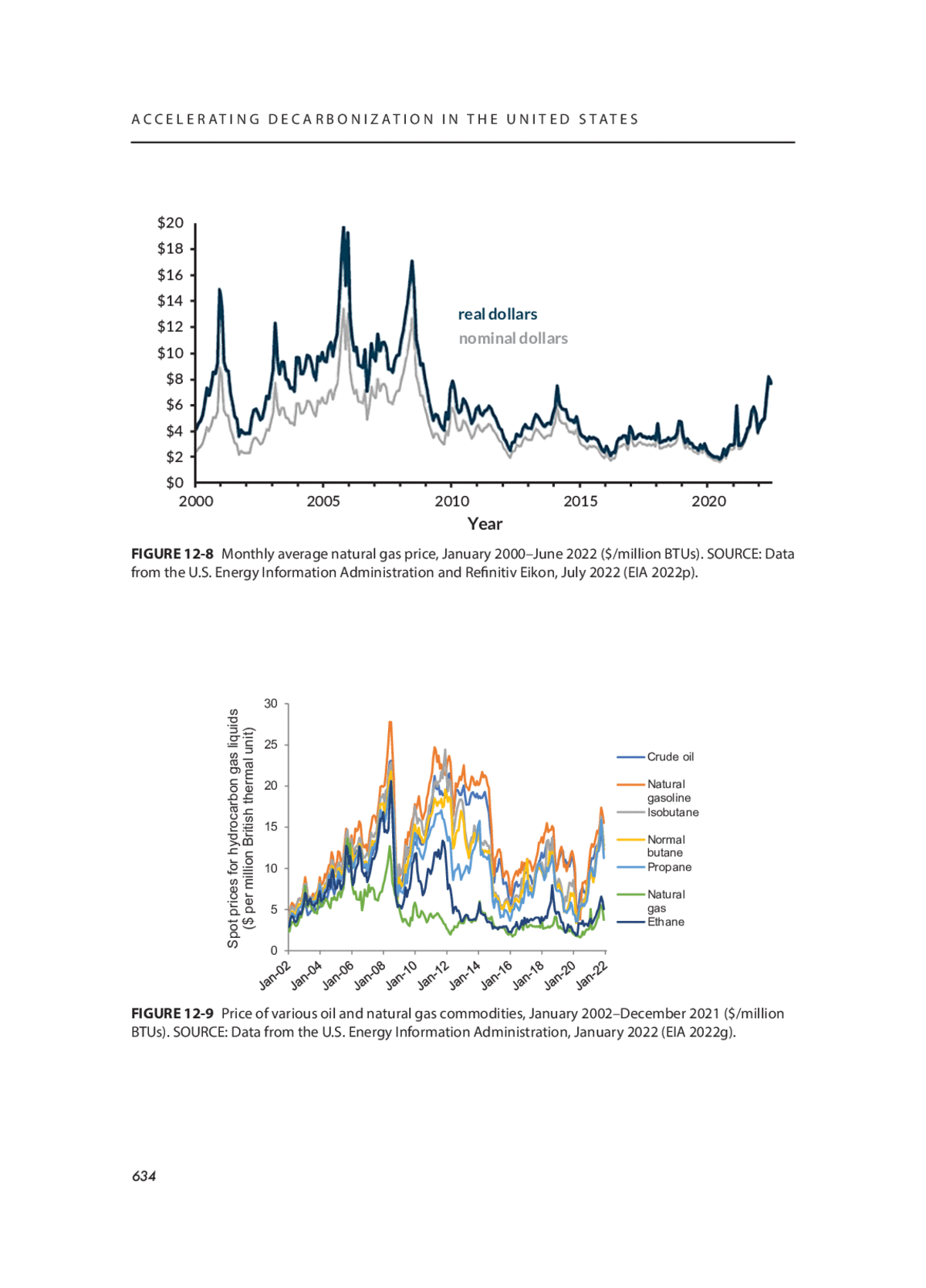12
The Future of Fossil Fuels
ABSTRACT
Today, fossil fuels provide most of the nation’s energy supply, and their production, delivery, and use lead to the vast majority of U.S. greenhouse gas (GHG) emissions and ambient air pollution.1 Most of those CO2 and ambient air-pollutant emissions result from use of fossil fuels, rather than their production and transportation, with methane leaks during natural gas production, processing, and delivery being the most significant exception. Other chapters of this report address the use of fossil fuels (e.g., in buildings, transport, and power production), while this chapter addresses the fossil fuel industries themselves.
Coal production and employment have declined dramatically over many decades, with economic impacts largely in Appalachian, Midwestern, northern Great Plains, and Rocky Mountain states. In contrast, domestic natural gas and oil production almost doubled over the past 15 years. Looking ahead over the next dozen years, coal use is expected to continue to decline, while oil and natural gas are likely to remain relatively flat and decline somewhat after 2030. Beyond 2030 and even during the current decade, the outlook for fossil fuels is highly uncertain and depends on how world events affecting global energy markets unfold; how fossil fuel prices and production costs vary relative to one another and relative to other energy resources; the development, economics, and deployment of energy technologies and electrification in vehicles, power plants, buildings, and industrial applications; the commercial and political viability of carbon capture; the build-out of energy delivery infrastructure; and other factors.
Further action is necessary to reduce emissions from the production and delivery of fossil fuels and to address transition impacts in regions tied to fossil fuel production; such transitions have been occurring for decades in coal-mining communities and may accelerate after the 2020s in communities where oil and gas are produced. Advanced notice, planning, and preparation will be important to mitigate harms to affected workers and communities.
This chapter overviews developments in fossil fuel markets and policy that have occurred since the committee’s first report; assesses the extent to which these policies
___________________
1 Ambient air pollution refers to emissions of the criteria air pollutants regulated by the Environmental Protection Agency (EPA) through the National Ambient Air Quality Standards; these pollutants include ground-level ozone, particulate matter, carbon monoxide, lead, sulfur dioxide, and nitrogen dioxide.
and market conditions put the United States on track toward decarbonization by midcentury; discusses what still needs to be done to address barriers and impediments to action in these sectors consistent with a net-zero economy; and provides findings and recommendations. Key recommendations relate to funding and capacity building for fossil fuel communities in transition and for the states where those communities are located; advance notice of facility closures; use of public revenues from taxes and fees collected on fossil fuel extraction and power production in the near term to assist in these transitions; increased analysis and planning to understand the timing and location of communities and regions that will be affected by transitions in infrastructure and extraction; and consideration of GHG emissions in public determinations about proposals for fossil fuel infrastructure additions.
INTRODUCTION
Given the fundamental role that fossil fuel combustion plays in producing GHG emissions, the outlook for production, delivery, and use of fossil fuels is central to the success of decarbonization pathways. In 2022, CO2 emissions from consumption of oil, natural gas, and coal in the United States were 2,273 million metric tons (MMT), 1,746 MMT, and 935 MMT, respectively (EIA n.d.). Fossil fuels dominate energy consumption across all sectors, as shown in Figure 12-1, accounting for nearly four-fifths of total U.S. energy use as of 2020.2
- Oil: Approximately one-third of all energy consumption in the United States relies on oil, with the transportation sector almost entirely reliant on petroleum as its energy source. Two-thirds of petroleum use goes to fueling vehicles, and another fourth is used in industrial applications, with the remaining 6 percent used for heating in homes and commercial buildings and power plants providing peaking power (Conte 2021).
- Natural gas: Another one-third of U.S. energy use depends on natural gas, with consumption spread across multiple sectors. Thirty-eight percent of natural gas consumption is used to produce power. One-third is consumed
___________________
2 Note that Figure 12-1 shows the sources and disposition of energy consumed in the United States. It does not show total U.S. energy production, some of which is exported for use in other countries. Additionally, some domestic fossil fuel consumption comes from imports. For example:
- Oil: Historically, the United States has been a net importer of oil and petroleum products, but in recent years the nation has exported approximately the same volumes of oil products as it has imported (EIA 2022a).
- Natural gas: The United States has been a net exporter of natural gas since 2017. As of 2021–2022, exports accounted for approximately 10 percent of domestic gas production (EIA 2023a).
- Coal: In 2021, the United States exported approximately 14 percent of domestically produced coal (EIA 2022b).
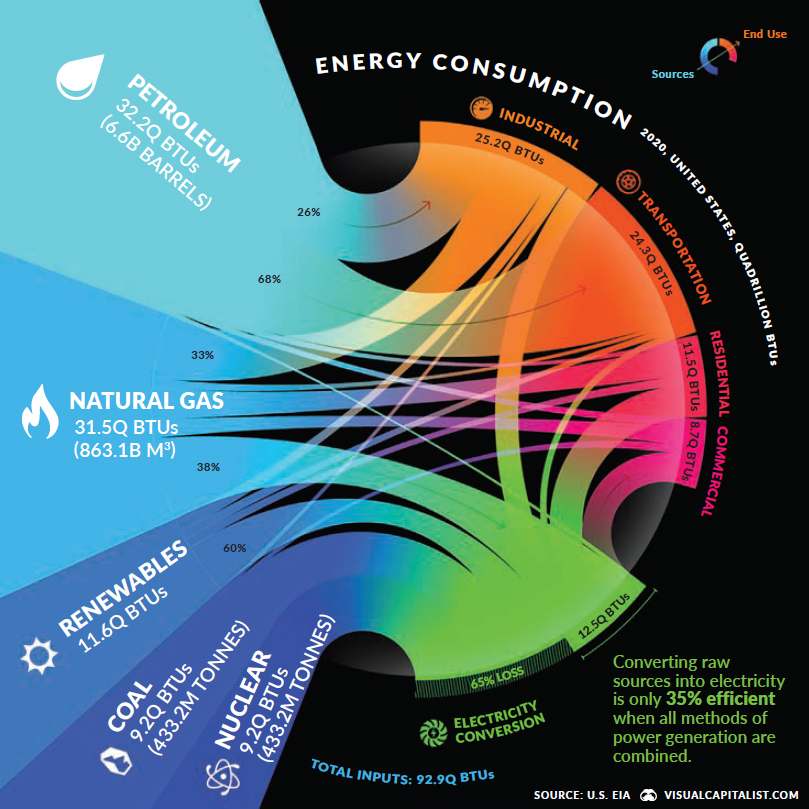
- by industries for energy (e.g., process heating, cogeneration of power and heat) and as a feedstock to produce other products (e.g., fertilizers, chemicals, hydrogen) (Conte 2021). The remaining natural gas consumption in the United States occurs in buildings for heat, hot water, cooking, and other energy services for households and businesses (EIA 2022i).
- Coal: Approximately 10 percent of total domestic energy consumption relies on coal. Over 90 percent of coal is used to produce power, with most of the rest going to export markets (Conte 2021).
The outlook for fossil fuel production and use in the United States varies among oil, gas, and coal and by different assumptions about how world events will unfold; how
fossil fuel prices and production costs will evolve; the development, economics, and deployment of energy technologies and of strategies to control emissions in vehicles, power plants, buildings, and industrial applications (including, e.g., through carbon capture and storage); the rate at which power lines and other delivery infrastructure are sited and built; and other factors.
These issues were complex and challenging at the start of 2021 when the committee published its first report. At that time and based on then-current law and policy, the Energy Information Administration (EIA) was projecting in its Reference Case that U.S. natural gas production and crude oil production would rise 14 percent and 10 percent, respectively, between 2022 and 2050 (EIA 2021a). The following year, EIA projected in its Reference Case that over that same period (2022–2050), gas production would rise 19 percent and oil production would increase 9 percent (EIA 2022b). EIA’s side cases indicated significant variance from these Reference Case outlooks.
The upheaval in global energy systems and the price volatility in oil and gas markets brought about by Russia’s war on Ukraine have made these issues even more complex and challenging.3 Economic-, energy-, and national-security considerations in global markets for fossil fuels (Birol 2022; Bordoff 2022a,b; EFI Foundation 2023; Victor 2021, 2022) add significant uncertainty about future outlooks for coal, oil, and natural gas—all of which are in plentiful supply in the United States. On top of that are challenges, and therefore uncertainties, about nations’ abilities to meet their climate commitments (Boehm et al. 2022; Gelles 2023).4 Additionally, as discussed later in the chapter, recent federal and state actions—including the passage of the Infrastructure Investment and Jobs Act (IIJA) in 2021 and the Inflation Reduction Act (IRA) in 2022—and technology, cost, and market trends could impact U.S. demand for and production of fossil fuels. The most recent EIA Reference Case forecasts that while domestic consumption of natural gas and oil remain relatively flat between 2022 and 2050, domestic production of both fossil fuels will increase over that same period largely as a result of fuel
___________________
3 “The global economy is facing significant challenges. Growth has lost momentum, high inflation has broadened out across countries and products, and is proving persistent. Risks are skewed to the downside. Energy supply shortages could push prices higher. Interest rates increases, necessary to curb inflation, heighten financial vulnerabilities. Russia’s war in Ukraine is increasing the risks of debt distress in low-income countries and food insecurity. The world is coping with a massive energy price shock. Russia’s war of aggression against Ukraine has provoked a massive energy price shock not seen since the 1970s. The increase in energy prices is taking a heavy toll on the world economy” (OECD 2022).
4 Ahead of COP-27, the Secretary-General of the United Nations said, “the war in Ukraine is putting climate action on the back burner while our planet itself is burning. We even see backsliding in some areas of the private sector—namely, around fossil fuels—while the most dynamic climate actors in the business world continue to be hampered by obsolete regulatory frameworks, red tape and harmful subsidies that send the wrong signals to markets” (Secretary-General of the UN 2022).
exports—with a wide range of outlooks for U.S. production depending on the scenario, ranging, for example, from –40 percent to +52 percent for domestic oil production and –20 percent to +36 percent for domestic natural gas production (reflecting the ranges for low and high gas price scenarios, respectively) (EIA 2023c). Investment in fossil fuels continues apace, even as investment in non-fossil technologies is increasing. IEA’s World Energy Investment 2023 report indicates continued growth in clean energy technology investments, projecting $1.7 trillion USD globally in 2023, compared to about $1 trillion USD for fossil fuels (IEA 2023). Nonetheless, fossil fuel investments are more than twice the level needed in 2030 to meet the IEA’s Net-Zero by 2050 Scenario, and oil and gas industry investments in low-carbon technologies remain, on average, at only 5 percent of spending on upstream oil and gas (IEA 2023). Recent analysis indicates that
phasing out [fossil fuel] transition assets too early may result in wild swings in oil and gas prices, raising energy security and affordability concerns, similar to what has transpired since Russia invaded Ukraine. Oil and gas price volatility can be an additional incentive to accelerate the energy transition, but in the short term it may move the world further away from the path to net zero . . . [and] could result in social and economic pain . . . via a higher cost of living and lower economic growth, and may severely impair the ability of many emerging economies to invest in clean energy sources. (Jain and Palacios 2023)
Currently, fossil fuels provide several functions to the energy system. First, and most obvious, they are primary sources of energy with high energy density. Second, they serve as energy carriers—that is, means of moving energy between one location and another. The other major energy carrier used today is electricity, with the crucial difference that electricity is not a primary source of energy (at least for now, ahead of any role for electricity in producing green hydrogen) but rather a means of moving energy from where it is produced (which could be a fossil fuel power plant, a nuclear plant, or a solar/wind facility) to where it is consumed. Just as electric transmission and distribution lines act as the means of carrying electrical energy, natural gas and oil pipelines act as a means of carrying fossil energy. The third role that fossil fuels currently play is storage. The fossil fuel energy system’s underground storage, pipelines, and tanks constitute a massive energy storage system, particularly suited for storing energy for long durations.
As the fossil fuel sector transitions, key uncertainties surround which parts of it will remain intact (presumably supplemented by offsetting carbon capture), which parts of it will be “generalized but replaced,” and which parts will be “eliminated and replaced.” The “eliminated and replaced” category refers to situations where renewable primary energy sources generate and move electric power, and then use it or store it with batteries or other means of storing electrical energy. “Generalized but replaced” refers to eliminating
fossil fuels as a primary energy source but continuing to use renewable fuels as means of carrying and storing energy. These renewable fuels could be biomass-derived or synthetic hydrocarbons produced with renewable energy, which may have compositions very similar to the refined petroleum products in use today (e.g., diesel, gasoline, jet fuel) and therefore provide the same high energy density as fossil fuels. Alternatively, these renewable fuels could be chemical energy carriers (e.g., ammonia or hydrogen) that are quite distinct from current refined petroleum products. Even if fossil fuels are largely eliminated, the mix of energy carriers that society ultimately adopts will have significant implications for regional economic impacts and jobs, as they influence the sectors involved in refining (e.g., synthetic fuel production), midstream transmission and distribution (e.g., pipelines carrying oil, natural gas, hydrogen, ammonia), and energy use. In addition, they influence the extent to which society creates a potentially massive new sector involving carbon capture, utilization, and storage that does not exist today.
Finding 12-1: In addition to being primary sources of energy, fossil fuels currently also serve two other functions: energy storage and energy carriers. These latter functions would also be served by renewable fuels—that is, chemical energy carriers that are synthesized (rather than extracted as in today’s fossil fuels) in a manner that generates no net GHG emissions on a life-cycle basis. Such renewable fuels could be “drop-ins”—that is, synthetic hydrocarbons that are very similar in composition to gasoline, jet fuel, or natural gas currently derived from fossil fuels, but manufactured using biological sources or from hydrogen extracted from water and captured atmospheric CO2. Alternatively, renewable fuels could consist of chemical energy carriers that currently do not have wide societal usage, such as hydrogen or ammonia.
This chapter examines key considerations about the future of fossil fuels as part of decarbonizing the U.S. economy:
- A brief review of relevant recommendations from the committee’s first report;
- An overview of developments in policy and markets that have occurred since that first report was published in early 2021;
- An assessment of the extent to which these policies and market conditions put the United States on track toward decarbonization by midcentury;
- A discussion of what still needs to be done to address barriers and impediments to action in these sectors to put them on a path to a midcentury net-zero economy; and
- Findings and recommendations (included in the relevant sections above). Table 12-5, at the end of the chapter, summarizes all the recommendations that appear in this chapter regarding the future of fossil fuels.
PRIOR COMMITTEE RECOMMENDATIONS RELATED TO FOSSIL FUEL INDUSTRIES
The committee’s first report did not specifically examine what happens to the fossil fuel industries themselves as the nation navigates paths to decarbonization but focused instead on policies in various other sectors that would naturally affect demand for and use of fossil fuels. These policies included:
- An economy-wide price on GHG emissions;
- A clean energy standard for reducing emissions in the power sector;
- Deployment of electric transmission infrastructures to support access to renewables;
- Support for zero- and low-carbon energy technology research, development, demonstration, and deployment (RDD&D);
- Energy efficiency standards and programs to reduce energy use in buildings;
- Performance standards for GHG emissions from motor vehicles;
- Planning and assessment of requirements for a national CO2 transport network and characterization of geologic storage reservoirs; and
- Low-carbon standards for federal procurements of goods and services (NASEM 2021a).
The committee also made recommendations to address social and economic challenges associated with communities whose economies, social structures, and cultures have been tied to either coal extraction or oil or natural gas production. These included:
- The establishment of a White House Office of Equitable Energy Transitions to report annually on energy equity indicators and triennially on transition impacts and opportunities (among other things);
- The establishment of a National Transition Corporation to ensure coordination and funding for job loss mitigation, critical infrastructure siting and deployment, and equitable access to economic opportunities, and to create public energy equity indicators;
- Funding to support subnational entities’ planning for the net-zero transition;
- The creation and funding of 10 regional centers to manage socioeconomic dimensions of the net-zero transition and of a net-zero transition office in each state capital; and
- The funding of local community block grants for planning and to help identify especially at-risk communities (NASEM 2021a).
RECENT DEVELOPMENTS AND EVENTS DIRECTLY AFFECTING FOSSIL FUEL INDUSTRIES
Market Conditions
Since the committee issued its first report, fossil fuel markets have reacted to the combined effects of the global COVID-19 pandemic and Russia’s war on Ukraine. But trends in the domestic coal, oil, and natural gas markets were changing even before those events.
Coal Production/Consumption, Employment, and Prices
U.S. coal production and consumption peaked around 2008 (Figure 12-2), largely owing to transitions in the electric industry, where virtually all U.S. coal use occurs (EIA 2020; see Chapter 6). Appalachian coal production had been relatively flat for more than 20 years before that (Tierney 2016), and with a few outlier years, coal-mining employment had declined across American coal-producing regions since the mid-1980s,5 primarily owing to mechanization. During the past decade, the number of mines in the United States dropped from 1,229 (in 2012) to 512 (in 2021), and production declined 43 percent during that period (EIA 2013, 2022c).
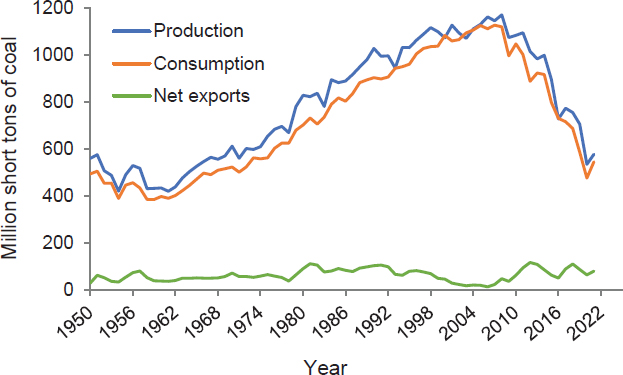
___________________
5 U.S. coal mining employment in September 2022 (41,000 people) was one-fifth of its levels in 1985 (approximately 178,000) (Federal Reserve Bank of St. Louis 2022).
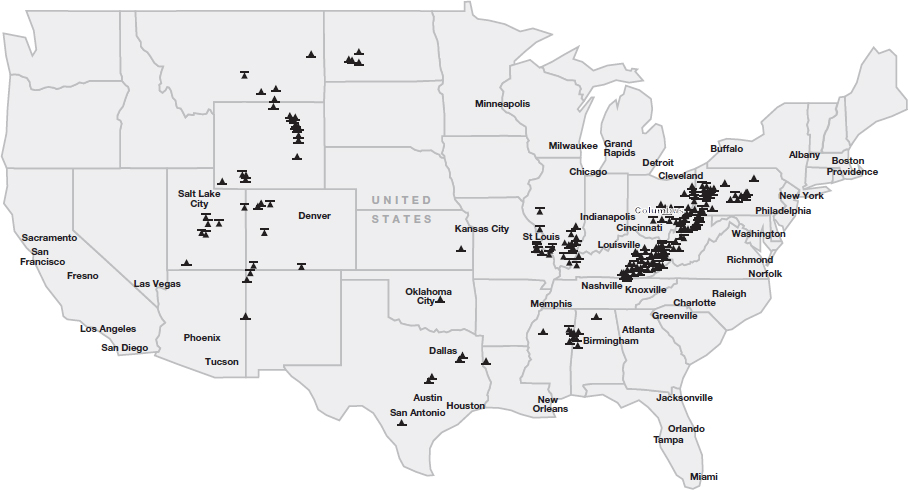
Historically, coal production has occurred primarily east of the Mississippi River in Appalachia and to a lesser extent west of the Mississippi River, especially in the Rockies. Most coal mines (including legacy ones with no current production) are in Appalachia (Figure 12-3), but eastern coal production has been in decline for 3 decades, whereas western coal production increased until it peaked a decade ago (Figure 12-4). Coal mining communities in both the east and west have now experienced economic pressure for many years.
Employment in the coal industry has also been in decline for decades—long before the peak in production. Figure 12-5 shows the long-term trends in coal mining employment, with declines driven primarily by productivity improvements, especially as production shares shifted to the West, where surface-mining techniques required fewer employees per ton of coal produced (Tierney 2016).6 On top of those productivity improvements, reduction in demand for coal during the past 2 decades further drove down both production and employment.
___________________
6 “Coal productivity ranges significantly across production regions, with productivity in the Powder River Basin far exceeding productivity in the Interior and Appalachian regions. U.S. coal mining productivity has increased despite mine closings and decreasing employment and production. Technology and process improvements have contributed to the increase in productivity, but a larger factor is the distribution of productivity across mines. The mines that are first to close during market downturns are often the ones with higher production costs and lower productivity, while more productive mines remain operating, increasing overall productivity” (EIA 2018).
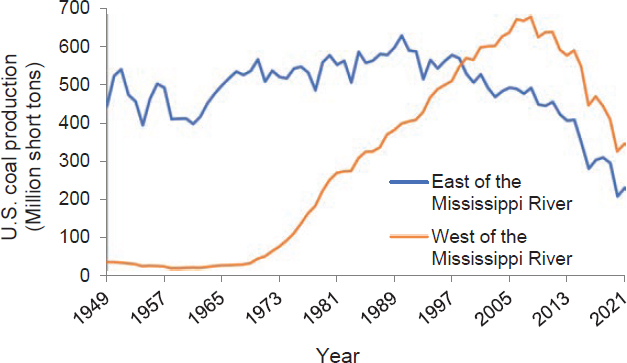
Coal-related economic activity more broadly—including mining, power production, and/or product manufacturing—occurs in almost every U.S. state, and the economies of nearly a quarter of the states are tied relatively tightly to coal—both as a fuel and as a source of electricity. This is especially true for Wyoming, West Virginia, and Kentucky, all of which experienced a decrease in coal-related activity in the past decade (Table 12-1). West Virginia has many more jobs in coal extraction compared to other
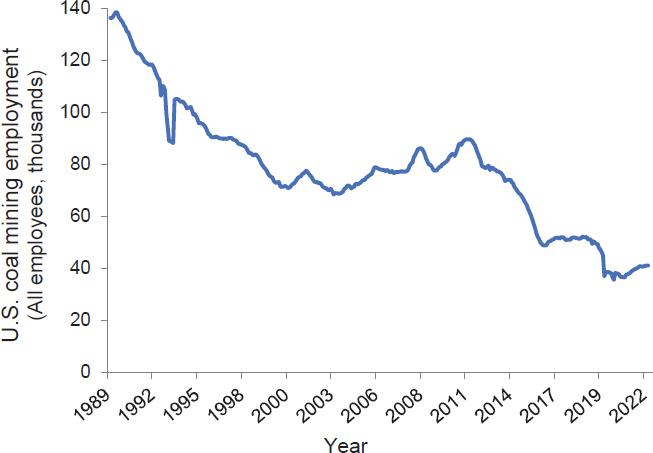
TABLE 12-1 Economic Activity Related to Coal: Ranking of Selected States
| Coal Production: Rank (in terms of % of U.S. production) | Coal-Fired Power Generation: Rank | Coal-Related Employment: Number | ||||
| State’s % of U.S. Coal-Fired Generation | State’s % Dependence on Coal-Fired Generation | Jobs in Coal Industry | Jobs Related to Coal-Fired Generation | |||
| 2012 | 2021 | 2021 | 2021 | 2021 | 2021 | |
| Wyoming | 1 (39%) | 1 (41%) | 9 (3.6%) | 3 (74%) | 4,859 | 936 |
| West Virginia | 2 (12%) | 2 (14%) | 2 (6.6%) | 1 (91%) | 12,261 | 1,808 |
| Kentucky | 3 (9%) | 7 (5%) | 5 (5.6%) | 4 (71%) | 5,425 | 1,550 |
| Pennsylvania | 4 (5%) | 3 (7%) | 10 (3.3%) | 29 (12%) | 5,062 | 1,784 |
| Illinois | 5 (5%) | 4 (6%) | 7 (4.8%) | 19 (24%) | 2,355 | 2,068 |
| Texas | 6 (4%) | 9 (3%) | 1 (9.9%) | 22 (18%) | 2,690 | 4,689 |
| Indiana | 7 (4%) | 8 (3%) | 4 (6.1%) | 6 (58%) | 1,924 | 2,918 |
| Montana | 8 (4%) | 5 (5%) | 29 (1.2%) | 9 (44%) | 1,161 | 356 |
| Colorado | 9 (3%) | 11 (2%) | 15 (2.6%) | 11 (42%) | 1,431 | 2,467 |
| North Dakota | 10 (3%) | 6 (5%) | 14 (2.7%) | 7 (57%) | 1,306 | 869 |
| Ohio | 11 (3%) | 16 (0.5%) | 6 (5.1%) | 12 (36%) | 937 | 10,126 |
| New Mexico | 12 (2%) | 14 (2%) | 27 (1.4%) | 13 (36%) | 931 | 206 |
| Other States with Relatively High Rank | Utah (10th) (2%), Virginia (12th) (2%), Alabama (13th) (2%) |
Missouri (3rd) (6.4%) Michigan (8th) (4.1%) Wisconsin (11th) (3.1%) Alabama (12th) (3%) Utah (13th) (2.9%) |
Missouri (2nd) (75%) Utah (5th) (62%) North Dakota (7th) (57%) Nebraska (8th) (50%) Wisconsin (10th) (43%) |
|||
SOURCES: Data for EIA Annual Coal Reports from EIA (2013, 2022a). Data for EIA Electric Generation Data by State from DOE (2022a) and EIA (2023c).
states that ranked relatively high in coal production in 2021. Ohio has many more jobs tied to coal-fired power generation than any other state, even though it ranks sixth in terms of its share of U.S. coal-fired electricity production. Notably, Ohio has more than double the employment of Texas (which, at the first-ranked position, produces 10 percent of all coal-fired electricity in the United States) and employs more people in coal-fired electricity generation than the 2nd-to-5th ranked states (West Virginia, Montana, Indiana, and Kentucky) combined.
Although coal prices were relatively flat over much of the past decade (Bloomberg 2022), power production at coal plants faced stiff competition from favorable prices and power-production economics at gas-fired power plants and the entry of new wind and solar generating units, and thus demand for coal declined. The uptick in coal prices in 2022 has been attributed to increases in demand for coal and energy shortages in Europe and elsewhere in the wake of Russia’s invasion of Ukraine (IEA 2022a).
Natural Gas Production/Consumption, Prices, and Employment
In contrast to coal trends in the 21st century, demand for natural gas has remained robust, especially since around 2010, with increases largely driven by power-sector consumption and to a lesser degree by exports of liquefied natural gas (LNG) in the past 5 years (Figure 12-6). As of 2021, electric power accounted for 36 percent of gas
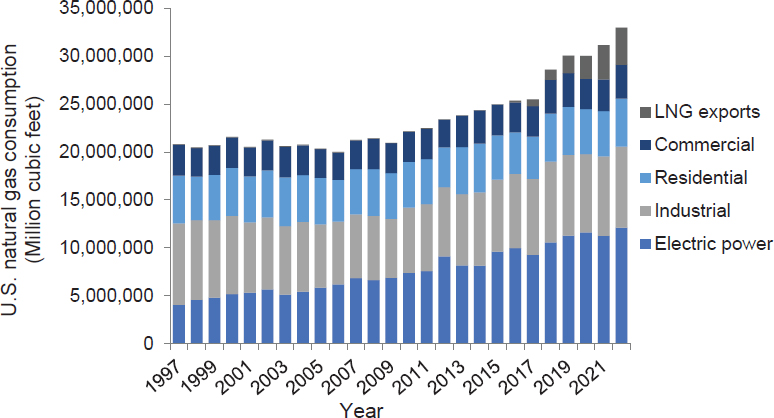
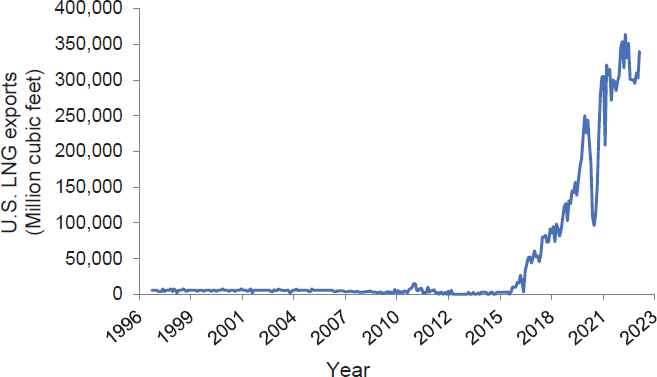
use; industrial use was 27 percent; and residential, commercial, and LNG were 15, 11, and 11 percent, respectively.
Most of this gas comes from domestic resources. Gas imports peaked in 2007, before U.S. production dramatically increased with the application of hydraulic fracturing (EIA 2022j). Domestic gas production has doubled since its recent low point in 2005 (EIA 2022j), with production relatively stable over the COVID-19 pandemic and recent upticks associated with global demand for U.S. LNG (Figures 12-6 and 12-7).
Once highly volatile, natural gas prices have been relatively stable and low over the past 15 years (as production increased since 2007)—again until global demand increased with the war in Ukraine and Russia’s cutoff of natural gas supplies to Europe (Figure 12-8).
Also of note is the fundamentally different pricing structure of natural gas relative to fuels like gasoline or crude oil that are liquid at room temperatures and thus easily and inexpensively transported globally. The prices of these fuels reflect conditions in their global markets. By contrast, U.S. natural gas prices tend to be driven by conditions in domestic markets because the fuel (like ethane) is gaseous at room temperature and pressure and has high transportation costs owing to capital-intensive liquefaction and gasification facilities and special-purpose transportation ships. (Figure 12-9 shows the price of several hydrocarbons on an energy basis, which reflects a fuel’s price relative to
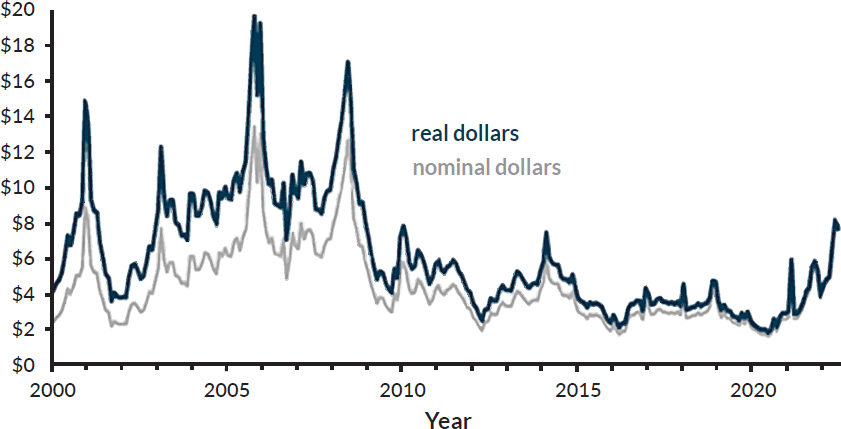
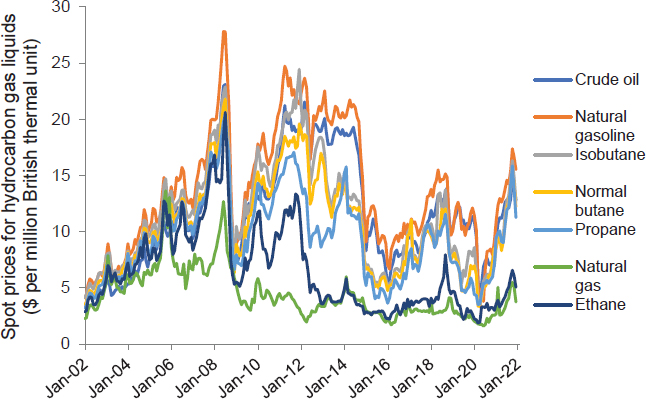
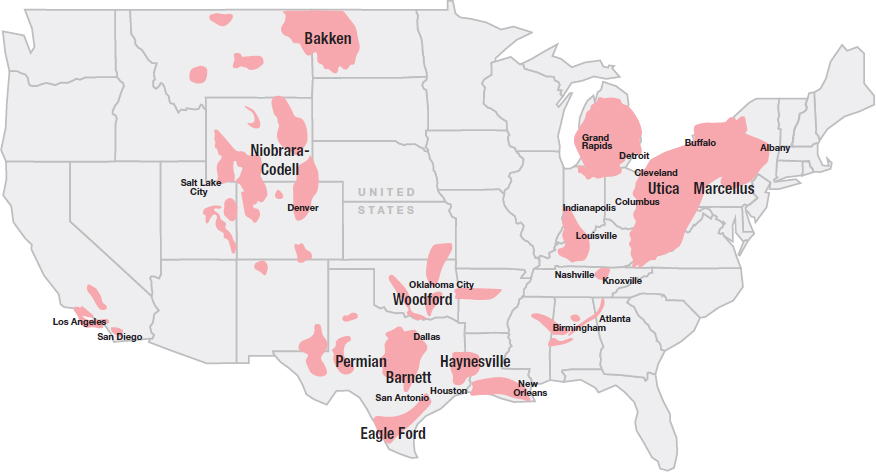
a given amount of energy it provides.) The structure of prices for these different fuels reflects their physical attributes as well as the economics of their markets.
Most of the natural gas resource base and production in the United States occurs in a few regions of the country. Figure 12-10 shows the location of shale gas plays,7 which are served by an extensive network of high-pressure gas pipelines. In 2021, 79 percent of U.S. gas production was in shale formations (EIA 2022n), with approximately 80 percent of shale gas production occurring in a handful of regions: the Marcellus and Utica (Pennsylvania, West Virginia, Ohio, and New York) and the Permian, Haynesville, Eagle Ford, and Barnett areas of Texas, New Mexico, and Louisiana (Figure 12-11). Figure 12-12 shows the states with the most natural gas production in the past 15 years.
Employment in gas production—typically combined with employment in oil production given the co-location of these fuels in many regions of the United States—has shown the same kind of volatility as gas prices (Figure 12-13). The high prices during much of the 2000s, combined with the decrease in production costs brought about by hydraulic fracturing toward the end of that decade, spurred new gas production, and demand for workers increased in response.
___________________
7 A shale gas play is defined as a “set of discovered, undiscovered or possible natural gas accumulations that exhibit similar geological characteristics” (DOE-FECM 2013).
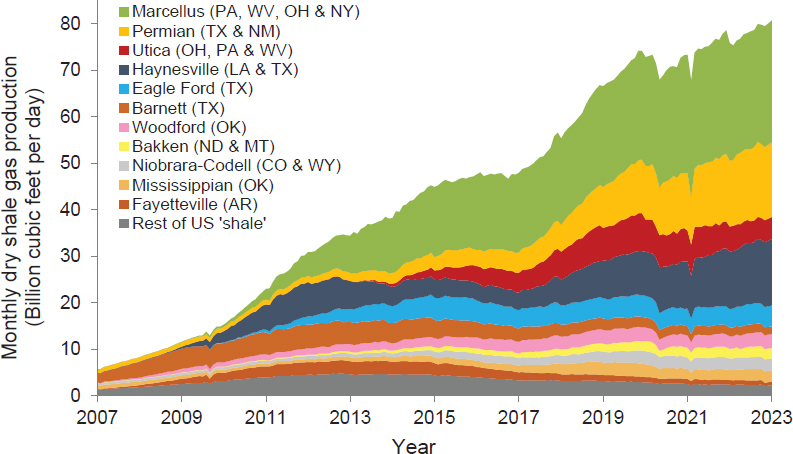
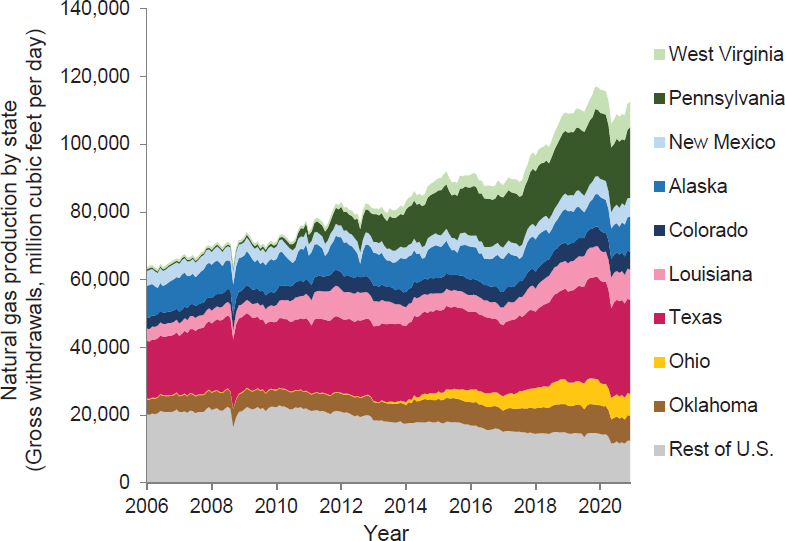
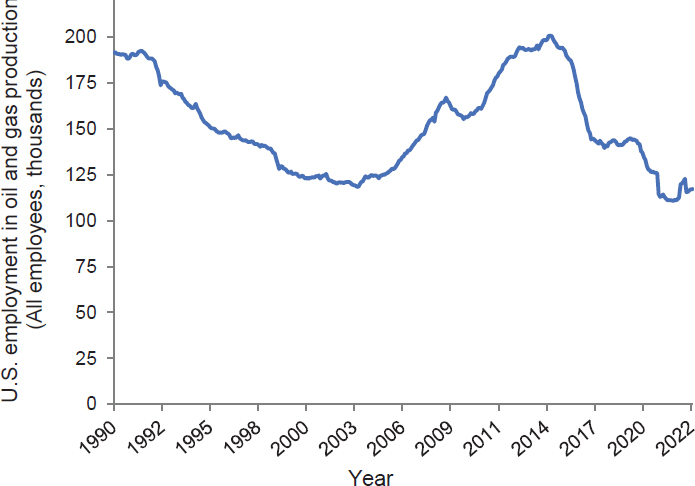
Oil Production
Like natural gas, U.S. oil production has seen growth tied to the application of hydraulic fracturing in basins with unconventional oil more than doubling over the past 15 years (Figure 12-14). (Nationwide employment figures for oil production are included in Figure 12-13.) As of 2021, oil production occurred primarily in the Gulf of Mexico (serviced by firms and people in the Gulf States like Louisiana and Texas), Texas, North Dakota, New Mexico, Oklahoma, Colorado, Alaska, and California (Figure 12-15).
The impact of oil production on these economies has been significant. Most recent estimates of economic impact include the combined effects of oil and gas production and other activities (because many data sources combine the two). For example, as summarized in Table 12-2, a 2021 study by PwC estimated direct economic impacts of oil and gas subsectors in 2019. An RFF analysis found that the upstream and midstream oil and gas sectors had annual public revenues of $34 billion and $8 billion, respectively, on average between 2015 and 2020 (Raimi 2023).
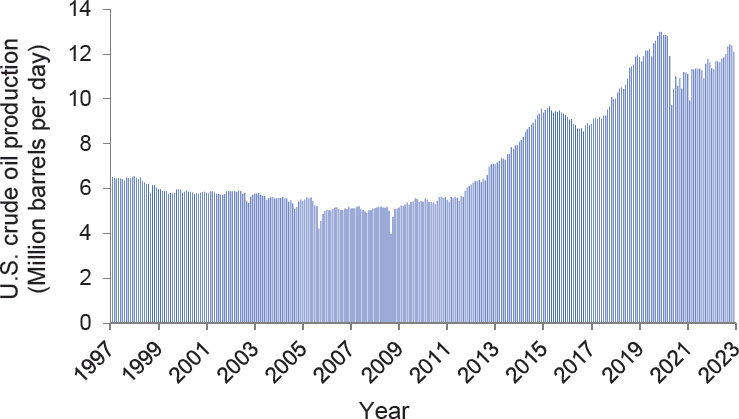
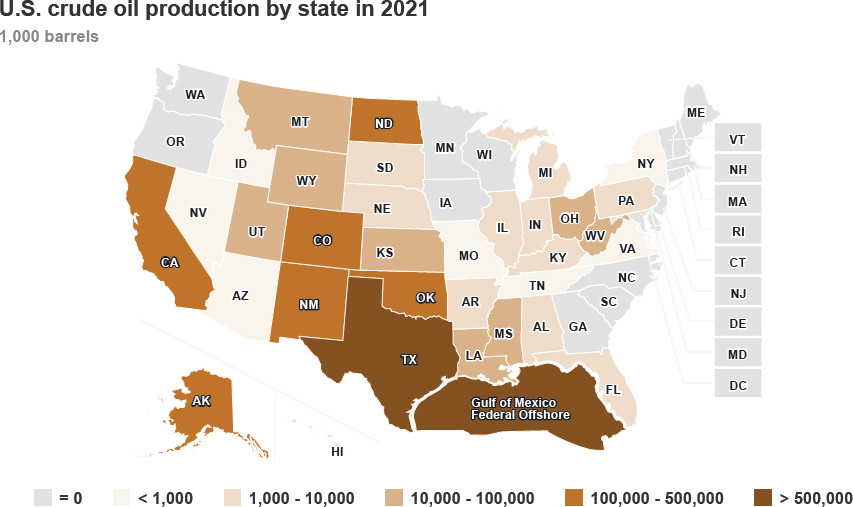
TABLE 12-2 Direct Impact of Selected Oil and Natural Gas Industry Activities on the U.S. Economy in 2019
| NAICS Code | Subsector | Jobs (thousands)a | Income from Labor (billions $)b | Added Value to Economy (billions $) |
|---|---|---|---|---|
| 211 | Oil and gas extraction | 507.0 | 106.6 | 193.1 |
| 213111 | Drilling oil and gas wells | 68.7 | 8.2 | 10.7 |
| 213112 | Support activities for oil and gas operations | 305.6 | 32.9 | 43.0 |
| 32411 | Petroleum refineries | 73.1 | 20.9 | 136.3 |
a Includes payroll and self-employed jobs, as well as part-time jobs.
b Includes wages salaries, benefits, and proprietors’ income.
SOURCE: PwC (2021) estimates based on 2019 employment from the U.S. Bureau of Economic Analysis and supplemented by data from the U.S. Bureau of Labor Statics and U.S. Census Bureau and 2019 input–output relationships from the IMPLAN modeling system.
Upstream activities (i.e., oil and gas extraction, drilling of oil and gas wells, and support activities for oil and gas operations) were concentrated most heavily in Texas, Oklahoma, Louisiana, and Colorado (PwC 2021, Table 7).
Trends in Fossil Fuels as of 2023
There are clear trends across the three fossil fuels: coal production continues to decline, while natural gas and oil production have not only avoided declines but in fact have increased in the past decade. U.S. domestic production of oil and natural gas is playing a strategic energy-security role internationally at present, with the United States positioned to rely on domestic production for its own supply and for serving export markets. This is a major change from earlier decades when the nation depended on imports of oil for most of its petroleum use.
Employment
In 2021, direct employment in fossil fuel industries amounted to 743,872, which was 0.5 percent of total employment and 9.5 percent of energy-sector jobs (DOE 2022d).8 Employment across fossil fuel industries, especially in jobs related to extraction, has been declining.9 The impacts of such trends are being experienced by communities in many states—in particular in Appalachia, parts of the Rockies, and the south-central parts of the United States—with a higher-than-average percentage of jobs involved in fossil fuels (not counting electricity generation) (Table 12-3). The economies of Alaska, Louisiana, North Dakota, New Mexico, Oklahoma, Texas, West Virginia, and Wyoming currently depend on activities in the fossil fuel sector. However, given the recent
___________________
8 The Department of Energy’s United States Energy and Employment Report: 2022 (DOE 2022d, p. 1) defines “energy sector jobs” as “all the professional, construction, utility, operations, and production occupations associated with energy infrastructure, production, and use” and more specifically:
- Electric Power Generation: “jobs across all electric generating technologies. This covers both utility and non-utility generation . . . [and] employment in any firms engaged in the manufacture, operation, and/or maintenance of turbines and other generating equipment, as well as those engaged in the construction and installation of electricity generation plants or other sources of electricity (e.g., solar panels), capital investments, and wholesale parts distribution for all electric generation technologies” (p. 11).
- Fuels: “any work related to fuel extraction, mining, and processing. This includes firms that manufacture machinery that supports oil and gas extraction, as well as coal mining. Agriculture and forestry workers who support fuel production with biodiesels, corn ethanol, and fuel wood are also included . . . [as are jobs for] the production of nuclear fuels for power plants. Jobs in electricity fuel to power vehicles and buildings are reflected in the Electric Power Generation section” (p. 78).
- Motor Vehicles: This includes “the manufacture of new vehicles and parts, construction of manufacturing facilities, and vehicle repair services” (p. 141).
- Energy Efficiency: “employment in the production and installation of products that increase energy efficiency and the provision of services that reduce energy consumption by the end-user. These jobs include building design and contracting services that provide insulation, improve natural lighting, and otherwise reduce energy consumption in residential and commercial areas. Additionally, this sector includes employment in the manufacture of ENERGY STAR labeled products” (p. 130).
- Transmission, Distribution, and Storage: “employment associated with constructing, operating, and maintaining energy infrastructure [including] electric transmission lines, pipeline construction, fuel distribution and transport, and the manufacture of equipment used for electrical transmission. Also included in this sector is employment related to storage technologies such as batteries, pumped storage, compressed air, and other utility-level storage methods. The TDS sector includes both legacy power lines and newer technologies such as microgrids and smart grids” (p. 65).
9 From 2020 to 2021, for example, and across all jobs in energy “fuels” (including renewable-energy fuels, nuclear fuels, and fossil fuels), the jobs lost were in extraction, which saw a decrease of 46,007 jobs (12 percent). Of these, the majority were in petroleum (31,593, a 6.4 percent decrease), although the greatest percent decrease occurred in coal jobs (a loss of 7,125, or 12 percent) (DOE 2022a).
TABLE 12-3 Jobs in Fossil Fuel Sector: U.S. Totals and Selected States with Above-Average Fossil Fuel Jobs (2021)
| Jobs in Fossil Fuel Industries | Fossil Fuel Jobs as % of Energy-Related Jobs | Fossil Fuel Jobs as % of Total Jobs | Energy Sector in the State with Highest Number of Energy Jobs (2021) | |
| United States | 743,872 | 9.5% | 0.5% | Motor Vehicles (2,553,368 jobs) Energy Efficiency (2,164,914 jobs) |
| Alaska | 10,175 | 41.1% | 3.3% | Fuels |
| Colorado | 22,330 | 15.3% | 0.8% | Energy Efficiency |
| Kansas | 9,076 | 11.7% | 0.7% | Motor Vehicles |
| Louisiana | 55,397 | 37.6% | 3.0% | Fuels |
| Mississippi | 6,777 | 10.1% | 0.6% | Motor Vehicles |
| Montana | 4,486 | 14.5% | 0.9% | Transmission, Distribution, Storage |
| New Mexico | 22,161 | 38.3% | 2.8% | Fuels |
| North Dakota | 23,659 | 46.7% | 5.9% | Fuels |
| Oklahoma | 48,258 | 38.8% | 3.1% | Fuels |
| Pennsylvania | 30,859 | 12.0% | 0.5% | Motor Vehicles |
| Texas | 247,604 | 28.1% | 2.0% | Fuels |
| West Virginia | 19,978 | 27.5% | 3.0% | Transmission, Distribution, Storage |
| Wyoming | 16,912 | 40.6% | 6.4% | Fuels |
SOURCE: Data from DOE (2022a,d).
increases in production in response to Russia’s war on Ukraine, fossil fuel employment was expected to increase in 2022 (DOE 2022d). (Note that for fuels, these employment statistics do not reflect jobs in service sectors associated with these fuels. For example, repair of internal-combustion vehicles using gasoline are reflected in the motor vehicles sector rather than the fuels category.)
As shown in Figure 12-16, a considerable portion of fossil fuel production takes place in areas that are currently considered economically distressed, especially in states close to the Gulf Coast, Appalachia, and parts of the southern Rockies (especially near tribal communities in Arizona and New Mexico).
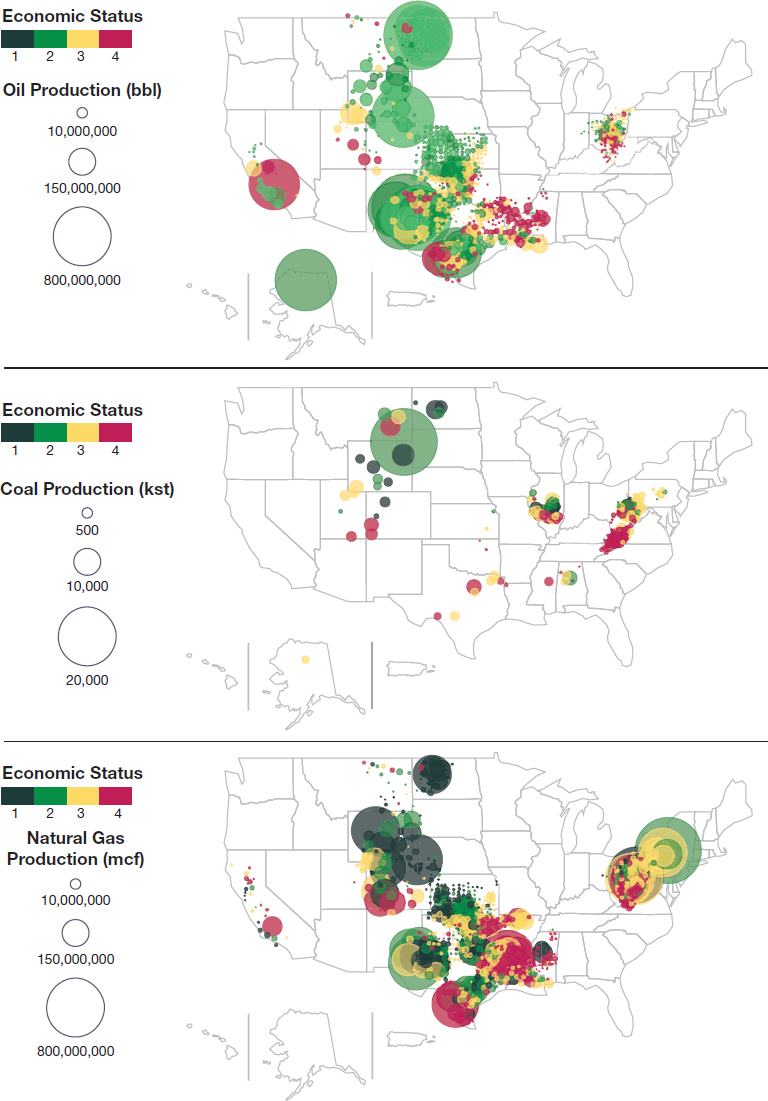
Tax Revenues
More than two-thirds of all U.S. states collect revenues via severance or other related taxes on the production of non-renewable natural resources (e.g., oil, natural gas, coal). As shown in Figure 12-17, such taxes provide an important source of revenues to state budgets in several states. In 2019, four states depended on severance tax revenue for more than 5 percent of state and local general revenues: North Dakota (23 percent), Wyoming (8 percent), Alaska (7 percent), and New Mexico (6 percent) (Urban Institute 2019). Five others—Louisiana, Montana, Oklahoma, Texas, and West Virginia—depended on severance taxes for 1–5 percent of state revenue. As severance tax revenues are tied to the production volume and price, fossil fuel severance taxes represent a relatively volatile source of public funds.10
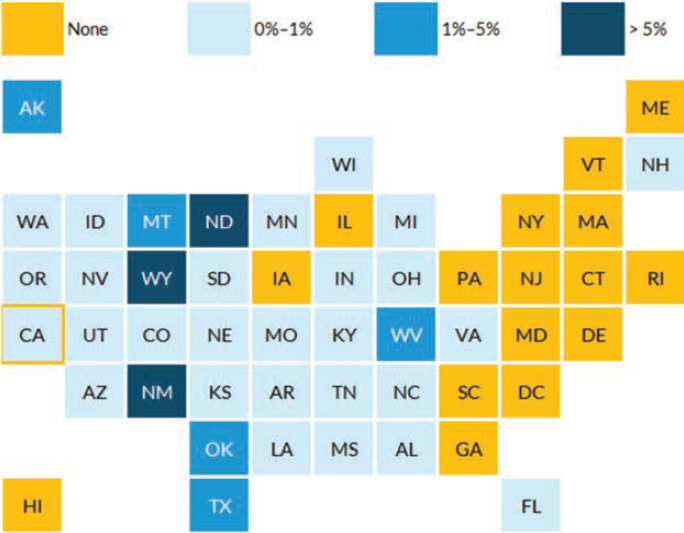
___________________
10 For example, Alaska’s severance taxes on oil and gas production accounted for 72 percent of state revenues in 2014 and 7 percent in 2019. Severance tax revenues represented the following percentage of public revenues elsewhere: North Dakota (54 percent in 2014, 23 percent in 2019), Wyoming (39 percent in 2014, 8 percent in 2019), and Texas (11 percent in 2014, between 1–5 percent in 2019) (EIA 2015; Urban Institute 2019).
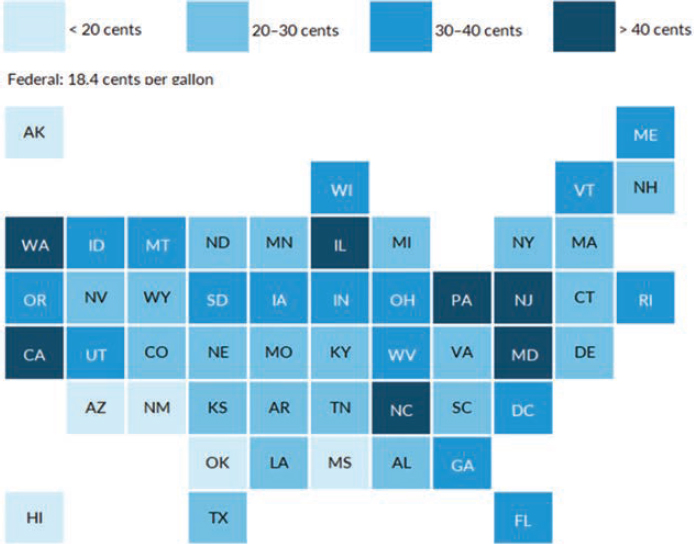
A notable suite of taxes related to fossil fuels are federal and state motor vehicle and highway taxes collected on sales of gasoline and other petroleum products. Since 1993, the federal government has collected 18.4 cents per gallon of gasoline sold and 24.4 cents per gallon of diesel fuel sold. All states and the District of Columbia also collect taxes on fuels, ranging from a high of 57.6 cents per gallon (Pennsylvania) to a low of 8 cents per gallon (Alaska) (FTA 2023) (Figure 12-18). These taxes and fees provide substantial revenues to the federal government (i.e., infusions into the Highway Trust Fund that finances construction on the federal highway and transit systems) and the states. In 2021, federal highway taxes generated approximately $43 billion, and in 2020 (the latest year available), local and state fuel tax revenues amounted to another $52.7 billion (CBO 2022; Tax Policy Center 2022).
Emissions
GHG emissions from fossil fuel combustion are typically allocated to the economic sectors that use the fuels as sources of energy (see Figure 12-1 and the sectoral chapters of this report). However, methane leaks and flaring from oil and natural gas
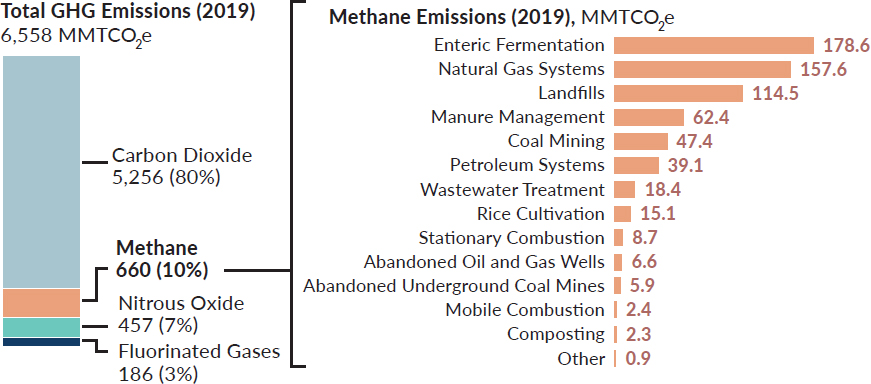
systems (e.g., production, processing, delivery, abandoned wells) accounted for approximately 3 percent of total U.S. GHG emissions in 2019 (Figure 12-19). Methane emissions, of which fossil fuel systems account for a substantial portion, amount to 10 percent of total U.S. GHG emissions, and methane is a potent GHG, with a 100-year global warming potential (GWP) of 27–30, compared to a reference value of 1 for CO2 (EPA 2023b).
GHG emissions from coal mining have declined over the past few decades, in line with the decline in overall coal production levels (Figure 12-20). GHG emissions from natural gas and petroleum systems (e.g., production, transmission, distribution, storage) have remained relatively flat over the past 3 decades (Figure 12-21), with reductions in emissions from local gas distribution systems offset by increased emissions from production. As Figures 12-20 and 12-21 illustrate, the magnitude of annual GHG emissions from production, extraction, and transportation of fossil fuels (~300–350 MMT CO2e) is much less than that from their combustion: 935 MMT CO2 (coal), 1,746 MMT CO2 (natural gas), and 2,273 MMT CO2 (oil) in 2022 (EIA n.d.).
Areas of Appalachia and Louisiana and parts of Gulf Coast Texas with significant fossil fuel production also experience high concentrations of PM2.5 (shown in red circles in Figure 12-22 below). PM2.5 and other co-pollutants associated with GHG emissions from a fossil-fuel economy are important issues for air pollution in local communities and the environmental justice outcomes of the energy transition. (See Chapters 2 and 3 on equity and health, respectively.)
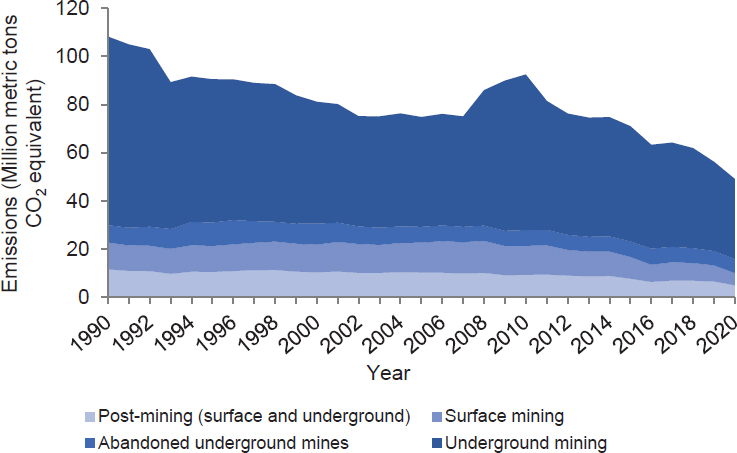
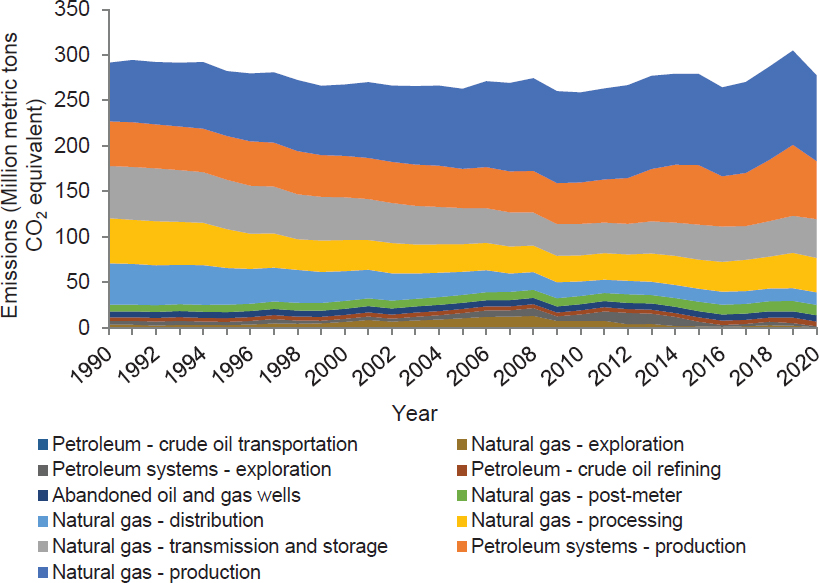
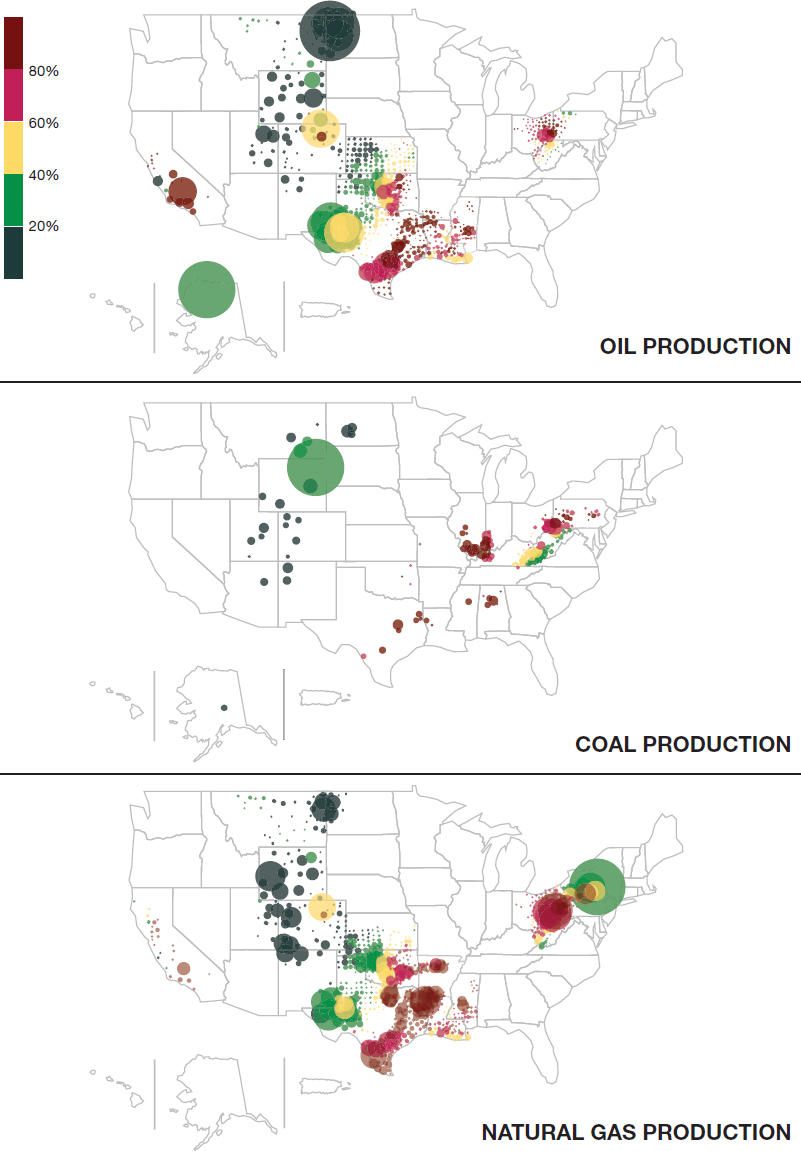
Finding 12-2: U.S. coal production and employment have declined dramatically over many decades, with economic impacts largely in Appalachian, Midwestern, northern Great Plains, and Rocky Mountain states. In contrast, domestic natural gas and oil production have almost doubled over the past 15 years. Most of the GHG and ambient air-pollutant emissions associated with fossil fuels result from their use rather than from their production/extraction and transportation, with methane leaks during natural gas production and processing the most significant exception.
Policy Changes in 2021 and 2022
Since the committee issued its first report in early 2021, federal action on fossil fuel production and transportation has focused on a handful of issues. Notably, even as the United States committed in 2021 to a “Nationally Determined Commitment” under the Paris Accord with a target to “achieve a 50–52 percent reduction from 2005 levels in economy-wide net greenhouse gas pollution in 2030” (White House 2021a), it did not sign on to the “Global Coal to Clean Power Transition Statement” that more than 40 countries signed as part of the 2021 Conference of the Parties (COP26) (Plumer and Friedman 2021).11 Nor did the United States, or other countries, agree to a phase-out of oil and natural gas as part of the 2022 COP27 meetings (Abnett and Nasralla 2022; Fickling 2022). That said, the United States did take several actions affecting direct emissions from the fossil fuel sector, including signing on to an international agreement with a hundred other countries to limit methane emissions to no more than 2020 levels by 2030 (White House 2021b) and entering into a bilateral agreement with China to cooperate in a number of areas (including on methane emissions) that are critical to encouraging decarbonization and electrification of end uses that currently use fossil fuels (DOS 2021).
Federal Executive Branch Actions Related to Fossil Fuel Industries
Four recent activities by the White House and federal agencies related to the fossil fuel industry and its workers are particularly significant: work on new methane policies by the Environmental Protection Agency (EPA); guidance from the Council on Environmental Quality (CEQ) that GHG emissions be considered in reviews of federal
___________________
11 The United States did, however, sign on to the agreement that would end financing of unabated coal, oil, and natural gas facilities in other countries (“Statement on International Public Support for the Clean Energy Transition,” 2021).
action under the National Environmental Policy Act (NEPA); policy on reviewing natural gas infrastructure project proposals by the Federal Energy Regulatory Commission (FERC); and formation of and assessments by the Interagency Working Group on Coal and Power Plant Communities and Economic Revitalization.
EPA’s Methane Policies
One area of recent executive branch effort focused on the fossil fuel industry involves the regulation of methane emissions from oil and gas production, processing, and transport. In June 2021, President Biden signed a joint resolution of Congress, which, under the Congressional Review Act, repealed a Trump administration rule that removed methane as a pollutant regulated in the oil and gas industries under the Clean Air Act (Traylor and Toley 2021). In November 2021, EPA proposed a policy aimed at reducing methane emissions from new, modified, and reconstructed sources in the oil and natural gas industry. This proposed regulation would establish a comprehensive monitoring program and require companies to fix any leaks discovered at new and existing well sites and compressor stations (i.e., “fugitive emissions”). It would also require states to develop plans to establish emissions standards for facilities within their borders (EPA 2021a). Then in November 2022, EPA proposed supplemental regulations that would strengthen the prior regulatory requirements and complement provisions in the IRA that incentivize implementation of technologies to monitor and mitigate methane emissions (EPA 2022). (See further discussion below.)
CEQ Guidance on GHG Emission Impacts in NEPA Reviews
In January 2023, CEQ published interim guidance that federal agencies consider effects of GHG emissions and climate change in their NEPA reviews of proposed major federal actions (CEQ 2023). Citing concerns about impacts of climate change, and particularly those that could exacerbate environmental injustice, CEQ stated that “NEPA reviews should quantify proposed actions’ GHG emissions, place GHG emissions in appropriate context and disclose relevant GHG emissions and relevant climate impacts, and identify alternatives and mitigation measures to avoid or reduce GHG emissions” (p. 1197) It encouraged agencies to pursue actions consistent with national emissions reductions goals (CEQ 2023). CEQ stated its intention to finalize guidance on these issues after receiving and reviewing comments from the public.
FERC Policy on Reviewing Natural Gas Infrastructure Proposals
FERC, which has jurisdiction on whether to approve interstate natural gas pipelines and LNG facilities, issued proposals for how the agency will address (among other things) the need for such facilities, their associated GHG emissions, and their impacts on local communities, with special attention to environmental justice (FERC 2021). First in early 2021 and again in February and March 2022, FERC specifically asked for public comment on whether and how it should incorporate GHG emissions into its environmental reviews and determinations of public need (FERC 2022). Under the current operative 1999 Policy Statement, the commission has approved nearly every pipeline facility proposal and did so upon a showing for “project need” that the pipeline company had an agreement with a party seeking additional pipeline capacity and without other indications of project benefits or costs (including such things as GHG emissions) (Tierney 2019, 2021).
Interagency Working Group on Coal and Power Plant Communities
In January 2021, the Biden administration issued Executive Order (EO) 14008, Tackling the Climate Crisis at Home and Abroad, which among other things established an Interagency Working Group on Coal and Power Plant Communities and Economic Revitalization (IWG). This working group was tasked with coordinating the identification, development, and assessment of economic and social resources to support and revitalize coal, oil and gas, and power plant communities, as well as preparing reports on such efforts (Lawhorn 2022). In April 2021, IWG issued an interim report that identified the places that would be most affected by declines in coal production and use (see Figure 12-23) and recommended actions to address worker and other economic impacts in these communities (IWG 2021).
Although IWG itself has not received congressional appropriations, its website (http://energycommunities.gov) features a clearinghouse of approximately 180 federal funding opportunities (as of May 2023) that is searchable by status, department/agency, funding type, program purpose, and eligible recipients. IWG’s interim report made several immediate and near-term recommendations, including (but not limited to):12
- Investing in Job-Creating Infrastructure Projects
- Providing Access to Rural Broadband
___________________
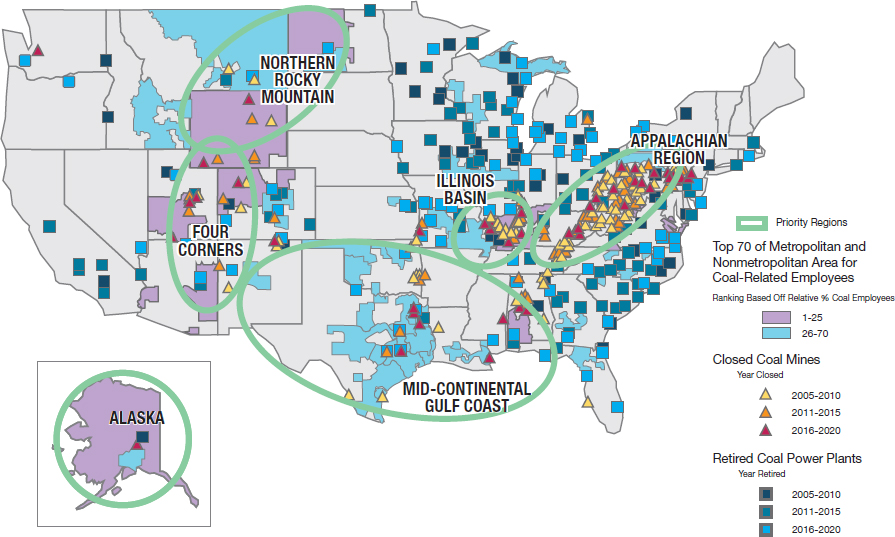
- Investing in Technological Innovations
- Funding for Small Businesses
- Investing in Financial Institutions Serving Energy Communities
- Creating Good Jobs by Reclaiming Abandoned Mine Lands
- Financing for Economic Development Aligned Workforce Training
- Funding to Revitalize Brownfields
- Investing in Economic Revitalization in Appalachia
Finding 12-3: The Interagency Working Group on Coal and Power Plant Communities and Economic Revitalization has been helpful for transitions in coal communities, but there is no parallel, coordinated effort under way to address and plan for transitions affecting regions heavily dependent on oil and/or natural gas production.
Recommendation 12-1: Authorize and Provide Appropriations for State Transition Offices to Address Coal, Oil, and Natural Gas Community Transitions. Congress should authorize and provide multi-year appropriations for state transition offices to undertake and implement the recommendations of
the Interagency Working Group on Coal and Power Plant Communities and Economic Revitalization. Additionally, either this coal-related working group should be expanded to include transitions of oil and natural gas communities or the White House should establish a parallel interagency working group to address such transitions, with congressional funding for the oil and gas transition efforts.
Federal Legislative Action
The IIJA includes provisions to address legacy pollution in and around abandoned coal mines and to plug orphan oil and gas wells. It authorizes $4.7 billion to plug, remediate, and reclaim orphaned wells located on federal, state, tribal, and privately owned lands (IIJA §40601) and $11.3 billion for the Abandoned Mine Reclamation Fund, with increased fees charged for coal production to support abandoned mine reclamation (IIJA §40701).13 The IIJA also includes provisions for research, development, and demonstration (RD&D) on carbon capture, utilization, and storage (CCUS) technologies that could be used to reduce emissions from facilities relying on fossil energy sources.
In addition to providing support for non-fossil investment, the IRA includes provisions that support development of oil and natural gas on public lands. For example, when the Department of the Interior issues leases for offshore wind in federal waters, the federal government must also offer offshore lease sales for oil and gas development. The IRA increases offshore oil and gas royalty rates and minimum bids associated with onshore oil and gas leases.14
The IRA established a methane emissions charge for facilities reporting more than 25,000 tonnes CO2e per year with methane emissions that exceed a certain threshold; these excess methane emissions are charged at $900 per tonne in 2024, $1,200 per tonne in 2025, and $1,500 per tonne for 2026 and beyond (IRA §60113). It appropriates $1.55 billion (through EPA) in the form of grants, financial incentives, loans, rebates, and other means to support methane emissions monitoring, reporting, and
___________________
13 For abandoned mine reclamation fees, Title VII “adjusts the rates of the Abandoned Mine Reclamation Fee to 22.4 cents per ton of coal produced by surface coal mining, 9.6 cents per ton of coal produced by underground mining, and 6.4 cents per ton for lignite coal. This section also extends the fee until 2034” (BIL Summary 2021, p. 81).
14 The IRA increases the minimum offshore oil and gas royalty rate from 12.5 percent to 16.66 percent and stipulates that the rate be no more than 18.75 percent in the first 10 years after the bill’s enactment (IRA §50261). It also increases the minimum for onshore oil and gas leasing from $2 to $10 per acre for the first 10 years after the bill’s enactment (IRA §50262).
source plugging; to deploy innovative technologies for methane emissions reduction; and to improve climate resilience, mitigate health impacts, and restore environments in communities affected by oil and gas systems (IRA §60113). Also aimed at reducing GHG emissions, the IRA extends and enhances the tax credit for carbon capture (the so-called 45Q program), adds a tax credit for direct air capture, and includes a “direct pay” provision that creates incentives for non-tax-paying entities to participate in such programs (BPC 2022).
Additionally, the IRA includes two programs to help finance transitions in communities. First, it appropriates $27 billion in funding for the EPA GHG Reduction Fund (discussed in Chapter 11), whose programs may directly or indirectly provide investment benefits in communities adversely affected by the energy transition. Second, it includes a new loan program called the Energy Infrastructure Reinvestment (EIR) Program with $5 billion in appropriations available through September 30, 2026, and a total cap on loans of $250 billion (IRA §50144). It amends Section 1706 of the Energy Policy Act of 2005 so that DOE may “guarantee loans to projects that retool, repower, repurpose, or replace energy infrastructure that has ceased operations, or enable operating energy infrastructure to avoid, reduce, utilize, or sequester air pollutants or anthropogenic emissions of greenhouse gases” (DOE 2022b). DOE’s Loan Programs Office provides several examples of eligible project types, including repurposing fossil energy facilities or infrastructure to support clean energy production and adding emissions control technologies, such as carbon capture, to existing energy infrastructure (DOE 2022b).
State Action
Many states have adopted executive or legislative targets to reduce GHG emissions from their economies,15 including a handful of states with relatively significant economic activity tied to fossil fuels (e.g., coal mining and oil and gas production) (Figure 12-24). Comparing the map in Figure 12-24 with the states listed above in Table 12-1 (states with significant coal mining) and Table 12-2 (states with relatively high levels of employment in fossil fuel industries), “fossil” states committed to GHG emissions reductions are Colorado, Illinois, Montana, New Mexico, and Pennsylvania. Colorado passed legislation committing it to net zero by 2050, while Illinois, Montana, New Mexico, and Pennsylvania have executive branch commitments.
___________________
15 As of November 2022, 25 states (as well as the District of Columbia and Puerto Rico) had made some sort of commitment (e.g., economy-wide, power sector, buildings, vehicles, industry, just transition, and/or lands) that is tied directly or indirectly to GHG emissions reductions (UC Berkeley 2023). These include all of the states shown in Figure 12-25, as well as New Hampshire and Hawaii.
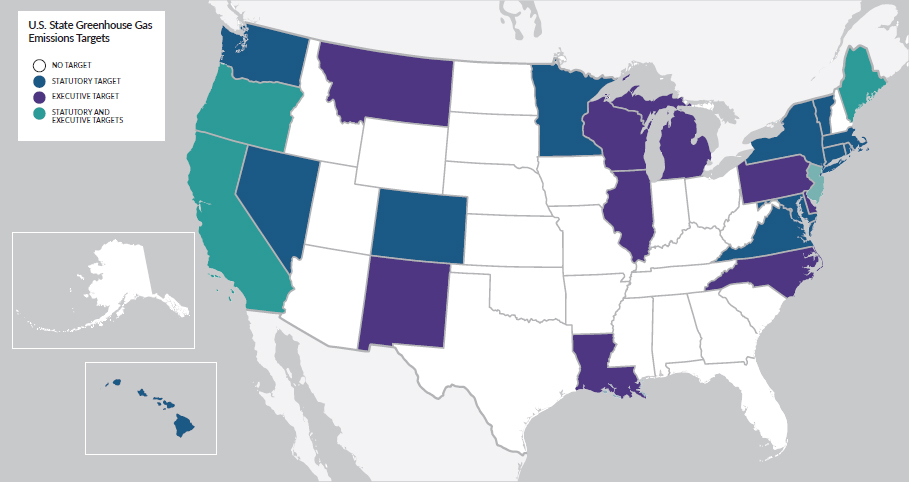
HOW FAR DO CURRENT/NEW POLICY AND MARKET CONDITIONS GET US?
Several modeling efforts have projected the potential impact of recent federal legislation on production and consumption of fossil fuels, GHG emissions, and economic outcomes as of 2030 and 2035. All found continued demand for oil and natural gas, with a diminishing role for coal.
For example, EIA’s assessment (which includes a reference case along with two other bookend cases that rely on high and low assumptions about market participants’ “uptake” of financial incentives offered under the IRA) projects that domestic natural gas production will increase through 2050 in all cases, largely owing to increased global demand (EIA 2023d). In the two IRA cases (High Uptake and Low Uptake), natural gas production is estimated to be 1–5 percent lower than in the No IRA case through 2050. Exports of LNG are expected to increase in all cases, and “particularly in the Reference and High Uptake cases because of reduced natural gas demand for power generation and relatively low domestic natural gas prices, which support wider spreads between domestic and international LNG prices” (EIA 2023d, p. 4).
The REPEAT Project analyzed two scenarios of global and domestic demand for oil and gas, with high and low production estimates varying as a function of changes
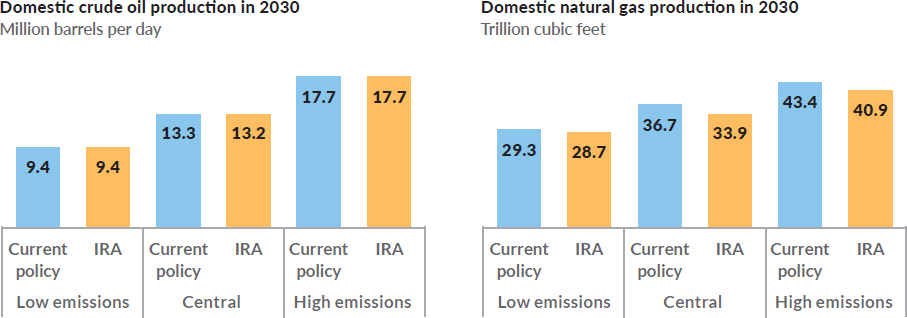
in domestic demand and product exports (Jenkins et al. 2022b). The REPEAT analysis estimated that the IRA’s incentives, combined with provisions in the IIJA, will increase demand for and deployment of CCUS as “a viable economic option for the most heavily emitting industries, such as steel, cement, and refineries, as well as power generation from coal and natural gas” (Jenkins et al. 2022b, p. 17). It projected significant retrofits at existing coal-fired power plants (6 GW) and gas-fired power plants (18 GW) by 2030, resulting in 90 million tons of captured CO2 at power plants, along with another 110 million tons of CO2 captured by various industrial sites (Jenkins et al. 2022b). The option to retrofit plants with CCS contributes to continued demand for coal and natural gas, while helping to improve public health outcomes and to reduce employment losses in the oil and gas industries (Jenkins et al. 2022b).
The REPEAT Project also analyzed the implications of the IIJA and IRA for coal consumption under alternative assumptions about the development of electricity transmission infrastructure over the next 12 years. Across all transmission scenarios, coal use is estimated to decline by one-third to one half over that period (Jenkins et al. 2022a).
In its analysis of recent federal legislation, the Rhodium Group observed that the IIJA and IRA will decrease reliance on imported fossil fuels. Rhodium Group’s model estimates “the most economical way to meet demand for energy. . . . [T]he clean energy provisions in the IRA drive down demand for petroleum and even more so for natural gas. Domestic production and imports respond accordingly, even though more federal land is available for exploration. In 2030, crude production is effectively flat . . . when comparing the IRA with current policy [which in this analysis includes the IIJA], and gas production declines by 2–7% . . . with the IRA compared to current policy” (Larsen et al. 2022, p. 9; see Figure 12-25).
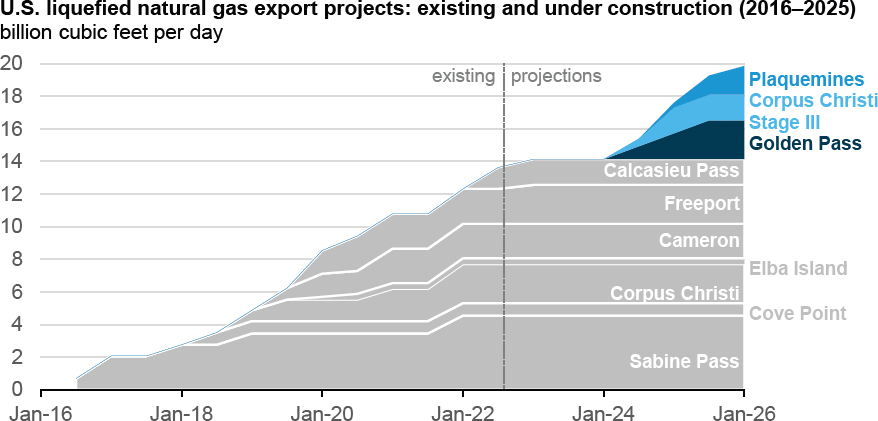
As a point of reference, in 2021, domestic production of crude oil amounted to 11.2 million barrels per day, and natural gas production was 34.5 trillion cubic feet (EIA 2022j,n). Thus, under the central scenario, the Rhodium Group estimates an increase in domestic oil production by 2030 and a slight decrease in natural gas production by 2030.
The market for exports of natural gas has shown recent strength given global energy market dynamics, including those brought about by Russia’s war on Ukraine. Previously approved LNG liquefaction capacity to enable exports of domestic LNG is moving into construction (Figure 12-26), which aligns with expectations in the REPEAT analysis and the Rhodium Group’s estimates of continued demand for domestic natural gas production. Estimates show that it takes 3–5 years to build an already-permitted LNG export facility and put it into commercial operation in the United States (Global Energy Monitor 2022). The three projects currently under construction will increase LNG export capacity by more than 40 percent relative to current capacity. The key market pull for expanded U.S. exports of natural gas is the dramatically lower price in the United States relative to global markets (IEA 2022c).
Researchers at the World Resources Institute (WRI) also modeled the impact of recent federal policies on changes in GHG emissions as well as energy-economy employment (Shrestha et al. 2022). The WRI analysis estimated that federal legislation providing tax incentives, infrastructure investments, and targeted spending (“advanced tax credit scenario”) would decrease GHG emissions and produce a 5-million net increase
TABLE 12-4 Estimates of Employment Impacts in Two 2035 Policy Scenarios
| 2020 | 2035 Reference Case | 2035 Federal Policy Case | |
| Total U.S. energy economy employment | 16.584 million | 20.807 million | 21.677 million |
| Net change in U.S. energy economy jobs | — | +4.223 million | +5.093 million |
| Fossil fuel employment | 4.268 million | 4.115 million | 3.214 million |
| Change in fossil fuel employment | — | −0.153 million | −1.053 million |
SOURCE: Data from Shrestha et al. (2022).
in energy sector employment in 2035, which would be 0.87 million more jobs than in a reference case without such policies. However, the analysis also found that there would be employment losses in several areas related to fossil fuels.
The WRI study compared a “reference” scenario without any of the new federal policies, an “advanced tax credit” scenario with new policies similar to those in the IIJA and IRA, and a “net-zero” scenario with additional policies (including sector-specific performance standards such as a clean energy standard and economy-wide net-zero emissions cap). It found that the fossil fuel sector would see significant jobs losses, primarily in petroleum, natural gas, and coal mining and extraction, and that the growth in biofuel and hydrogen employment would not offset these losses (Shrestha et al. 2022). The WRI analysis estimated that the advanced tax credit scenario would lead to a net decrease in fossil fuel jobs and fossil fuel–related electric power jobs of approximately 0.95 million by 2035, relative to the reference scenario (which also was expected to see a job loss relative to 2020). Excerpted estimates of employment impacts in the WRI analysis are shown in Table 12-4.
Economic modeling of recent federal legislation estimates continued reductions in coal production and use, with relatively flat oil and gas production during the next decade. These modeling studies indicate that the legislation will likely put the nation on a path toward decarbonizing the power, building, and transportation sectors, with significant reductions in GHG emissions anticipated over the next decade. Beyond 2030–2035, additional policies, investments, and actions will be required to reach net-zero targets by midcentury. (Discussion of the results of these studies and recommendations related to the sectors that consume fossil fuels can be found in other chapters of this report.)
Finding 12-4: Despite the positive progress in policy change since the committee’s first report in early 2021, much more is needed. Federal policy has focused
insufficient attention on the recent and anticipated transitions affecting communities tied to fossil fuel extraction and production. A National Transition Corporation (see the committee’s first report [NASEM 2021a] and Chapter 1 of this report) offers an institutional framework to fund and guide strategic action on community transition over the next several decades.
CONTINUING IMPEDIMENTS AND GAPS AFFECTING CLIMATE-RELATED ACTION IN THE NATION’S FOSSIL FUEL INDUSTRIES
Compared to business-as-usual outlooks, recent actions in markets and policy will change the nation’s fossil fuel production levels, delivery, consumption, and systems. Many changes (notably coal production and use) have been under way for some time, driven by market forces and existing policies. But accelerated change can now be expected because of recent additions to climate and energy policy that will affect not only fossil fuel use, but also all the other systems that support their production, delivery, and transportation within the U.S. economy.
This chapter focuses on gaps in and impediments to new federal policies directly targeting the fossil fuel industry, rather than on policies (like the incentives for deployment of alternative technologies) whose indirect impacts will cause most of the expected decline in fossil fuel–related emissions. The primary barriers to intended fossil fuel emissions reductions are the gaps and barriers identified in those other chapters, which might result in either changes in energy-transporting and/or energy-using infrastructure that are too little or too late. If the recent EPA-proposed regulations to control power plant and industrial CO2 emissions are adopted and implemented,16 if facility owners take advantage of the IRA’s enhanced 45Q financial incentives for implementing carbon capture and sequestration technologies (Kelly and Nelson 2023), and if sufficient renewable and electricity-storage capacity exists in 2030–2035, then coal use might be reduced but not eliminated, while oil and gas consumption will be close to what it is today. Chapter 6 discusses how public pushback could frustrate or prevent the buildout of new transmission capacity or the installation of carbon capture technologies on existing or new power plants, which in turn could impede deployment
___________________
16 In May 2023, EPA proposed new regulations to control carbon emissions from existing and new fossil-fueled power plants and large industrial facilities, with emissions standards reflecting the “best system of emission reductions” “based on either 90 percent capture of CO2 using CCS by 2035, or co-firing of 30 percent by volume low-GHG hydrogen beginning in 2032 and co-firing 96 percent by volume low-GHG hydrogen beginning in 2038” (EPA 2023b).
of renewable capacity. Limited availability of critical minerals necessary for clean energy technologies could also impede renewable deployment. With these constraints, combined with increased electrification, fossil emissions might then actually increase through 2030.
Thus, near-term uncertainty about the size of and activities in the U.S. fossil fuel industry in 2030 is dominated by impediments to policies targeting other sectors, as well as the forces directly affecting global fossil fuel supply, demand, and prices. On the other hand, there is considerable uncertainty about the nature and size of the fossil fuel industry from 2030–2050, which will be strongly shaped by current and future federal policy.
Finding 12-5: Numerous, significant technological, economic, behavioral, and market uncertainties make it impossible to project with assurance the roles and specific mix of fossil fuels in upcoming decarbonization pathway(s). Nonetheless, most estimates indicate that fossil fuels will continue to provide a significant share of energy during the 2020s, with most of the uncertainty affecting outcomes in the 2030s and beyond. There are at least three key drivers of this uncertainty: (1) policy; (2) the degree to which carbon capture is socially acceptable and cost competitive; and (3) the role of electrification (e.g., as opposed to renewable fuel substitutes for fossil fuels) as means for carrying and storing energy.
Techno-Economic Uncertainties
Uncertainty affects different stakeholders’ willingness to accept or reject an ongoing role for fossil fuels in a decarbonized economy. Examples of such uncertainties are multiple and confounding, and affect not only the character of fossil fuels’ roles in the economy but also the timing of changes in production, transportation, and use.
Take the future of coal, for example. Demand for coal is tied to transitions in the U.S. power sector, where almost all of U.S. coal is consumed. As explained in Chapter 6, state decarbonization commitments, federal and state policies, and power-market economics that favor renewable power sources and gas-fired generation are expected to decrease coal-fired power generation and demand for domestic coal production dramatically over the next 10–15 years. In the absence of commercially available and economically attractive CCUS technology and the buildout of infrastructure to serve coal-fired power plants outfitted with CCUS, coal plant retirements can be expected to continue over the next decade and a half, perhaps
even eliminating coal as a source of generating capacity in the United States by the mid-to-late 2030s.17 In such circumstances, coal-related employment will continue to decline, putting economic stress on those communities and states whose economies are tied to coal mining and coal-fired power production. On the other hand, many stakeholders’ hopes for the success of CCUS may create resistance to walk away in the near term from assets that could have economic and technical value in the future. Some stakeholders involved in the mining sector may even argue that the U.S. coal industry should be a larger player in global markets for coal (where emissions from power plant and industrial uses would not be reflected in U.S. territorial emissions under most modeling approaches, but which would nonetheless be included in global emissions budgets and impact the climate).18 The presence of critical minerals and rare earth elements (REEs) in coal and coal by-products (see, e.g., DOE 2022c; NETL n.d.; Zhang et al. 2020) could also impact the prospects for coal, as there is great interest in establishing domestic sources of these materials for use in clean energy technologies (DOE 2022c, 2023). Providing an additional revenue stream for coal may lengthen the timeline for coal plant retirements, although processing coal wastes to extract critical minerals and REEs could have the benefit of cleaning up legacy environmental pollution.
Similarly, the outlook for natural gas remains uncertain. The prospects (e.g., timing and cost) for CCUS affect not only the use of coal but also industrial and power-sector demand for natural gas. More broadly, demand for natural gas for power generation varies across regions and the nation as a whole in light of uncertainty about the availability of other forms of flexible generation (e.g., storage, dynamic demand) and long-term on-demand power generation capability (e.g., long-duration storage). Given the current role of natural gas for heating and other end uses in buildings and in industrial applications, the pace of electrification affects how much gas will need to be produced and delivered into various regions of the country.
Uncertainty about the technical and economic ability to repurpose existing fossil-fuel delivery infrastructure (e.g., pipelines) for different energy carriers in the future (e.g., renewable gas, hydrogen) produces another challenge to understanding the
___________________
17 Researchers have analyzed the potential to repurpose the sites of recently retired coal-fired power plants. While such proposals might not extend the life of coal as a fossil fuel, they might address transition impacts of communities with economic attachment to such large infrastructure projects (Hansen et al. 2022). The IRA’s Energy Infrastructure Reinvestment Program administered by the DOE Loan Programs Office and described above will create incentives for such repurposing of sites.
18 Note that the United Kingdom recently decided to approve the first coal mine that would open in many decades, with the goal of providing jobs in the United Kingdom to produce steel for domestic and international markets (Ravikumar et al. 2022).
potential roles of such infrastructure in the future. If gas pipelines do not end up being suitable for other uses besides transporting natural gas and the commodity flows on some of those facilities decline (e.g., as a result of electrification of buildings and vehicles, or of decarbonization of the power system), then decisions will ultimately have to be made with regard to continued investment and expenditures to keep those pipelines in safe operating condition and to address any potential stranded costs. Such analyses may be facility-specific, as observed by a National Academies’ committee examining market and infrastructure considerations associated with use of CO2 for economic products and services: “Given the large number of parameters involved, the economic and operational feasibility of repurposing existing natural gas pipelines for transporting CO2 requires examination on a case-by-case basis using rigorous systems analysis, with techno-economic, safety, environmental, and justice considerations being the overarching factors” (NASEM 2023, p. 100).19
Decisions about repurposing and/or decommissioning any existing natural gas pipelines, or about adding new natural gas pipelines, will be made in the first instance by their owners and shippers, but additionally by regulators (e.g., FERC for interstate gas pipelines; state regulatory agencies for intrastate pipelines) in proceedings that will likely become increasingly contentious with different stakeholders’ positions on the long-term need for, and safety and economics of, such facilities. These discussions introduce differing perspectives on the potential option value of maintaining infrastructure, for example, and the cost of doing so in a world of declining use of fossil fuel–based natural gas by a system that must remain in safe operations for as long as any consumer demand is served by facilities on that system. (See Chapter 5 on public engagement.)
Because discussions of the future of gas-delivery infrastructure typically do not differentiate between declining use of natural gas derived from fossil fuels and other
___________________
19 NASEM (2023) made two potentially relevant recommendations as well:
- Recommendation 5.6. Regulatory authorities in charge of siting infrastructure should account for distributional impacts of CO2 utilization projects through a process that considers equity and justice for disadvantaged groups, engages impacted communities early and throughout the project planning, and allows for alteration of project design and implementation (p. 125).
- Recommendation 6.1. The U.S. Department of Energy should support its national laboratories, academia, and industry to leverage their competencies in techno-economic and life cycle assessments, as well as integrated systems analysis, to identify the best deployment and investment opportunities from the myriad of utilization options, avoiding those that are technically feasible but not sustainable or economically attractive. These assessments should consider relevant regulatory and policy frameworks and environmental justice impacts, as well as factors that may influence societal acceptance of the technologies (p. 133).
gaseous forms of energy, issues associated with the phase-out of fossil fuels like natural gas do not necessarily mean the phase-out of chemical energy carriers, such as hydrogen, synthetic natural gas, synthetic liquid fuels, and ammonia. The future of these other non-fossil-based energy carriers will influence the future of midstream and downstream delivery infrastructure and systems.
Finding 12-6: Transition impacts on jobs and local communities differ based on whether they are associated with fossil fuel extraction, processing/refining, transportation, or utilization. For example, there may continue to be a significant role for the latter three of these if there is significant uptake of renewable fuels, such as hydrogen or sustainable aviation fuels.
Finding 12-7: If oil and gas production, processing, and delivery volumes decrease in the future, companies in these sectors will continue to need investment to ensure safety and environmental compliance for as long as these facilities are being used during the net-zero transition. With sufficient planning and problem solving, such investments could occur without inadvertently extending the uneconomic lives of the facilities or by maintaining the ability of such facilities to be repurposed for supporting other fuels in a decarbonized economy.
Recommendation 12-2: Consider Whether Proposed Natural Gas Pipeline Projects Are Needed, Incorporate Greenhouse Gas (GHG) Emissions Impacts into National Environmental Policy Act (NEPA) Analyses, and Require the Use of Depreciation Periods for Pipeline Application Reviews. Congress should direct the Federal Energy Regulatory Commission to incorporate the following considerations into the agency’s reviews of applications for new interstate natural gas pipeline capacity and liquefied natural gas terminal capacity:
- Consider whether the proposed project is needed in light of projections of GHG emissions reductions consistent with a net-zero economy by midcentury.
- Incorporate the GHG emissions impacts associated with production, transportation, and use of the gas that is proposed to be transported by the facility application into NEPA analyses and project need determinations.
- Require, in decisions regarding the recovery of costs of jurisdictional natural gas facilities, the use of depreciation periods that take into account facility lives consistent with a net-zero economy by midcentury.
Uncertainty About Behavior in Markets, Social Systems, and Politics
Apart from uncertainty about the technological readiness and costs of various options that affect future demand for fossil fuels, there are other social, political, and consumer preference issues that affect the uptake of equipment, devices, facilities, and infrastructure that relies on other non-fossil fuels.20
Events in 2020–2022 have heightened awareness that unexpected global and geopolitical events can disrupt markets for fossil fuels, as occurred in the many months following Russia’s invasion of Ukraine, the continuing war there, and the consequences for European reliance on Russian natural gas. These events have already changed the outlook for LNG exports from the United States, as well as the implications for demand for increased gas production domestically.21 Although European countries have responded with significant modifications in their own energy requirements, uncertainty about these circumstances remains as of the committee’s writing.
Demand for natural gas and oil in the United States a decade from now will be greatly affected by the pace and extent to which consumers and businesses purchase electric vehicles (EVs) and that building and industrial plant owners—whether homeowners, landlords, or owners of commercial buildings—convert various end-use equipment (e.g., heating, water heating, cooling) to electricity and otherwise adopt energy efficiency measures. Projections of adoption of non-fossil appliances and conversion of equipment tend to focus on economic considerations. Individual decision makers will make their choices based on economic and other criteria, some of which—like range anxiety over EV driving distances, convenience factors for EV charging, concerns about performance issues associated with heat pumps, uncertainty about the ability of local contractors to install and service electric appliances and/or solar technology systems—are not yet tested or well understood in the literature (see, e.g., IEA 2022b; NASEM 2021b). These factors could render forecasts of electrification to mis-estimate changes in equipment—either overshooting or underestimating what ends up happening.
___________________
20 “‘This transition that we need to make to clean energy is complicated and will take time,’ Heather Boushey, a member of Mr. Biden’s Council of Economic Advisers, said in an interview last year. ‘And it requires changing some of the biggest, most expensive things that people buy: a boiler, a car, how they cool their home, what kinds of transportation they drive’ ” (Tankersley 2023).
21 The National Academies (NASEM 2023) included a recommendation (4.1) that agencies “with authority over LNG facilities—including the U.S. Department of Energy, the Pipeline and Hazardous Materials Safety Administration, the Federal Energy Regulatory Commission, and the U.S. Coast Guard—should collaborate to assess the possibility of repurposing existing LNG facilities for CO2 liquefaction, as well as the feasibility of co-designing any future facilities to be able to compress both natural gas and CO2” (pp. 99–100).
Suppliers of fossil fuels and alternatives may attempt to influence these decisions in one direction or another, making it hard to plan on such things as utilization rates of natural gas pipelines or retail gasoline stations.
In some places, local governments have tried to make certain outcomes more predictable—for instance, by putting in place moratoria on extensions of natural gas service or prohibitions on gas heating systems in new buildings.22 Some of these have been contested and are subject to legal challenges.23 Concerns have been raised in Congress to push back on actions that would restrict access to natural gas use in buildings (Shao and Friedman 2023), and as of early 2022, 20 states had enacted “preemptive laws” to foreclose the adoption of such actions by localities in those jurisdictions (Cunningham and Narita 2021).
Utility regulators in various states with carbon-reduction commitments or mandates have begun to focus attention on various issues associated with the future of local gas distribution utilities and their existing customers (Solomon and Tallackson 2022; Zitelman 2022). With electrification of buildings, power systems, and industrial uses, sales of traditional forms of natural gas service will decrease, but customers who remain in need of natural gas service will require access to supply delivered over safely operating local and higher-pressure gas pipelines. Lower sales volumes will naturally lead to revenue erosion for the local utility, which will need to continue to spend money on maintaining and operating the system infrastructure. Fewer sales over an existing asset base with such ongoing costs will have adverse consumer price impacts, all else equal, potentially further reducing demand. Those consumers slower to transition to electrification—which, based on previous examples of shrinking utility customer bases, are likely to be disproportionately lower-income households and people of color—would bear the burden of these higher costs (Davis and Hausman 2022). Local utilities, regulators, consumers, and other stakeholders will increasingly need to wrestle with such difficult challenges, including utility business model considerations.24
___________________
22 As of February 2022, 74 communities in California have banned natural gas in new buildings (Gable 2021). The City Council of New York City voted to ban natural gas in new buildings (Maldonado 2021).
23 In Massachusetts, for example, the City of Brookline instituted a moratorium on new gas hook-ups; this action was challenged and found to be unconstitutional as written. Subsequently, the Massachusetts legislature enacted a law in 2021 that included provisions allowing for communities to impose bans on gas in new buildings under certain circumstances. Those provisions are being implemented as of 2023 (Iaconangelo 2023; Van Voorhis 2022).
24 See, for example, regulatory proceedings related to the future of natural gas in Minnesota (Minnesota Public Utilities Commission 2021, 2022), with illustrative stakeholder views (Drake and Partridge 2021), and in Massachusetts (Massachusetts Department of Public Utilities 2022).
Finding 12-8: Local gas distribution utilities around the country have seen relatively flat sales of natural gas and have dealt with economic, financial, and regulatory considerations relative to these conditions. In parts of the country where electrification of end uses that now use natural gas is occurring or is anticipated to take place in the future, these challenges will become more acute. Many utility regulators and stakeholders in such communities are actively looking at the complex implications for utility business models, investment patterns, service provision, safety, and consumer rate impacts.
Recommendation 12-3: Require Utilities and Service Providers to Plan for the Transition. State regulators should require natural gas distribution utilities and fossil fuel supplier/service providers to plan for transitioning the investment in and operations of their pipeline and service-delivery systems to ensure safe operations and affordable delivery of gas as buildings and other end uses undergo electrification. Such investigations should consider how gas utilities with electric-distribution affiliates might use cost- or revenue-sharing approaches, and/or asset disposition options, to transition their systems safely and affordably.
Recommendation 12-4: Consider Adoption of Moratoria on New Gas Lines in Previously Unserved Areas. States and communities should consider adopting moratoria on extension of new gas lines into areas previously unserved by natural gas unless or until there is a showing that such extensions will reduce greenhouse gas emissions.
In places where transition discussions are under way as well as in other places, there are tenacious impediments to action on fossil fuels—many of which are discussed in other chapters. Fundamentally, as described in Chapter 11 and the committee’s first report, the absence of a price on carbon produces economic advantages for some, if not many, applications of fossil fuels owing to unpriced and unmitigated CO2 emissions from power generation using coal and natural gas; consumption of petroleum products in vehicles; use of gas, oil, and propane in buildings; and industrial use of fossil fuels. (See also the chapters on these sectors.)
Public, community, and/or political resistance to or lack of support for build-out of regional infrastructure (e.g., power lines, CO2 pipelines, sequestration sites, hydrogen facilities) that might otherwise facilitate relatively timely and efficient decarbonization strategies may prolong use of existing fossil infrastructure and production of coal, natural gas, or oil—or accelerate precipitous and destabilizing declines.
Financing and legal instruments related to existing infrastructure may inhibit what might otherwise seem like economic transitions away from use of fossil fuels. For example, the existence of long-term contracts or debt arrangements associated with investments in and/or ownership of existing coal-fired generating assets may impede their retirement, as might the desire to avoid creating stranded costs.
States and communities that depend on fossil-fuel royalty fees, severance taxes, property taxes, or other payments tied to facilities or activities in the fossil-fuel supply chain are particularly vulnerable to decarbonization transitions (Raimi 2023). One state—Illinois—has put in place a legislative requirement that in advance of a closure of investor-owned power plants and coal mining operations, the owner must give advance notice of the anticipated facility closure to local communities and workers.25 Such advanced notice allows for transition planning and other activities by the state, local community, and workforce.26 Initiatives from the IWG and some states (e.g., Colorado, see Colorado OJT 2020) offer lessons regarding what kinds of engagement, planning, and support have worked and what types are still missing. The IWG has recommendations related to federal grants on infrastructure projects, provision of access to broadband in rural areas, funding for small businesses and the financial institutions that support them in disadvantaged communities, grants for land reclamation and the revitalization of brownfields, and support for workforce training, which are ripe for implementation in light of the financial resources and technical assistance enabled by the IIJA and IRA (IWG 2021).
Furthermore, the federal government’s Highway Trust Fund has been stressed in recent years, in part because of flat collections of federal fuel taxes. There are multiple drivers of such collections, including the fact that the federal gas tax rate has
___________________
25 “An owner of an investor-owned electric generating plant or coal mining operation may not order a mass layoff, relocation, or employment loss unless, 2 years before the order takes effect, the employer gives written notice of the order to the following: (1) affected employees and representatives of affected employees; and (2) the Department of Commerce and Economic Opportunity and the chief elected official of each municipal and county government within which the employment loss, relocation, or mass layoff occurs.” Also: “An employer which is receiving State or local economic development incentives for doing or continuing to do business in this State may be required to provide additional notice” (Illinois CEJA 2021, pp. 954, 955).
26 Note that communities that host commercial nuclear power plants have tax bases and local economies tied to the operations of and jobs associated with such facilities. During the operations of such plants, the owners must maintain trust funds to support the costs of decommissioning the plants, with the consumers of electricity produced by the plants contributing to those trust funds over the life of the facility (NRC n.d.). In anticipation of closures, the owner must submit decommissioning plans to the Nuclear Regulatory Commission. Technical assistance programs have become available to aid local communities as they transition through the process of plant closures (SmartGrowthAmerica n.d.).
not changed in 3 decades, the increasing efficiency of vehicles (thus requiring lower purchases of petroleum product per mile driven), and the sales of vehicles that run on alternative fuels (e.g., hybrid or all-electric vehicles). These circumstances have eroded the ability of the Highway Trust Fund to pay for the federal share of highway and transit projects (GAO 2022). Other sources of funding—for example, some system that raises revenues based on vehicles’ mileage rather than purchases of petroleum products—have been in discussion (GAO 2022; Raimi 2023; TRB and NRC 2015), and the IIJA included a one-time transfer of $118 billion in general funds into the Highway Trust Fund to forestall anticipated insolvency of the fund for 5 more years (CRFB 2022).
Finding 12-9: Presuming that sales of electric, hybrid, and increasingly fuel-efficient vehicles continue to grow, then revenues from federal highway taxes (and support for the Highway Trust Fund) will decline in future years without some change in policy that affects new and/or revised sources of revenue.
Recommendation 12-5: Modify the Design of Taxes on Gasoline, Diesel, and Petroleum Products. Congress and states should replace their current highway user taxes and fees, which are based on gasoline, diesel, and other petroleum products that have been relied on to provide funding for highways and mass transit programs, with alternative funding mechanisms that are consistent with the user-pay principle for highway funding.
Last, many communities, institutions, investors, and others seek to retain the jobs, profits, tax base and public revenues, service industries, and myriad other economic activities in places where fossil industries currently operate. Some states have attempted, with mixed success, to mandate the continuity of coal-based economies by statute. For example, Montana’s legislature passed two laws in 2021 that fined out-of-state companies for refusing to fund long-term coal-fired power plant operations, but those laws were subsequently deemed unconstitutional (IEEFA 2022). Impacts have already been felt in communities where coal is in decline and are anticipated in other communities where fossil fuel extraction transitions are expected to occur in the years ahead. A model for providing federal assistance to communities impacted by fossil fuel transition assistance can be found in the American Rescue Plan’s “Coronavirus State and Local Fiscal Recovery Fund,” which allows states, localities, and tribal governments to apply for and use funding for a variety of purposes (including replacing lost public sector revenue and responding to the negative economic impacts [of the pandemic] on communities and households, small businesses, and others) (Department of the Treasury 2022).
Finding 12-10: Energy transitions in communities long dominated by fossil fuel industries and related activities are greatly affected by the reality that decisions about facility operations and closures tend to be made by firms that own assets and not by the communities that host them. Firms vary significantly in their sense of responsibilities to assist in these communities’ transitions. There are lessons in other technologies (e.g., commercial nuclear reactors), where decommissioning monies have been collected and reserved for use in the period after the plant is in operations, with the idea that the consumers who benefit from the operations of, say, a nuclear plant should pay for its eventual decommissioning and site cleanup and restoration. Such cleanup activities provide economic activities to local communities during transition periods.
Recommendation 12-6: Require Recipients of Federal Funding to Provide Advance Notice of Facility Closures. Congress should require that recipients (e.g., states, localities, companies, non-profits) of funding from federal agencies provide at least 2 years of notice prior to closure of federally funded facilities that would lead to worker layoffs exceeding 99 full-time equivalent employees.
Finding 12-11: Local and regional economies developed around extraction of fossil fuels will be greatly in need of economic and social support in conjunction with, if not ahead of, these energy transitions. State governments dependent on royalty payments from extraction of fossil fuels will be similarly affected by and in need of fiscal transition strategies. In these locations, planning for public service delivery under changing circumstances is a pressing issue, and one not adequately addressed in employment- or worker-focused assessments.
Recommendation 12-7: Fund the Decommissioning, Cleanup, and Just Transition for Communities Historically Dependent on Fossil Fuels. Congress and state legislatures should ensure the existence of funding in support of decommissioning, cleanup, and just transitions for communities associated with fossil fuel extraction and power production:
- States that currently receive royalty, severance tax, or revenues associated with extraction of fossil fuels should evaluate—and adjust as needed, the availability of revenue to assist in planning for just transitions in the communities affected by such resource extraction activities. Fossil fuel revenues should not be mixed in with general fund spending but should be invested in permanent funds to ensure long-term
- savings, while also providing funding for economic diversification and transition assistance.
- State agencies with permitting responsibility for oil and gas production within their borders should require the owner/operator of such facilities to maintain adequate financial reserves to cover and ultimately pay for closure and site decommissioning and restoration of the site and for impacts in the host communities.
- State regulators with jurisdiction over the recovery of a regulated utility’s costs related to existing or new fossil power plants should require that the owners of such plants include reserves for the eventual funding of cleanup/decommissioning of the site and its impacts on host communities. State utility regulators should continue to expand opportunities for rate recovery to address remediation/transition costs associated with use of fossil fuels, while protecting the utility bills of low- and moderate-income consumers.
Table 12-5 summarizes all the recommendations in this chapter regarding the future of fossil fuels.
SUMMARY OF RECOMMENDATIONS ON THE FUTURE OF FOSSIL FUELS
TABLE 12-5 Summary of Recommendations on the Future of Fossil Fuels
| Short-Form Recommendation | Actor(s) Responsible for Implementing Recommendation | Sector(s) Addressed by Recommendation | Objective(s) Addressed by Recommendation | Overarching Categories Addressed by Recommendation |
|---|---|---|---|---|
| 12-1: Authorize and Provide Appropriations for State Transition Offices to Address Coal, Oil, and Natural Gas Community Transitions | Congress and state transition offices |
|
|
Ensuring Procedural Equity in Planning and Siting New Infrastructure and Programs Ensuring Equity, Justice, Health, and Fairness of Impacts Building the Needed Workforce and Capacity Managing the Future of the Fossil Fuel Sector |
| 12-2: Consider Whether Proposed Natural Gas Pipeline Projects Are Needed, Incorporate Greenhouse Gas Emissions Impacts into National Environmental Policy Act Analyses, and Require the Use of Depreciation Periods for Pipeline Application Reviews | Congress and Federal Energy Regulatory Commission |
|
|
A Broadened Policy Portfolio Managing the Future of the Fossil Fuel Sector |
| Short-Form Recommendation | Actor(s) Responsible for Implementing Recommendation | Sector(s) Addressed by Recommendation | Objective(s) Addressed by Recommendation | Overarching Categories Addressed by Recommendation |
|---|---|---|---|---|
| 12-3: Require Utilities and Service Providers to Plan for the Transition | State regulators of natural gas distribution utilities and fossil fuel supplier/service providers |
|
|
Ensuring Equity, Justice, Health, and Fairness of Impacts Managing the Future of the Fossil Fuel Sector |
| 12-4: Consider Adoption of Moratoria on New Gas Lines in Previously Unserved Areas | States and communities |
|
|
Managing the Future of the Fossil Fuel Sector |
| 12-5: Modify the Design of Taxes on Gasoline, Diesel, and Petroleum Products | Congress and states |
|
|
Managing the Future of the Fossil Fuel Sector |
| 12-6: Require Recipients of Federal Funding to Provide Advance Notice of Facility Closures | Congress and recipients of federal agency funding |
|
|
Ensuring Equity, Justice, Health, and Fairness of Impacts Managing the Future of the Fossil Fuel Sector |
| 12-7: Fund the Decommissioning, Cleanup, and Just Transition for Communities Historically Dependent on Fossil Fuels | Congress, state legislatures, state agencies, and state regulators |
|
|
Ensuring Equity, Justice, Health, and Fairness of Impacts Managing the Future of the Fossil Fuel Sector |
REFERENCES
Abnett, K., and S. Nasralla. 2022. “COP27: Energy Crisis Leaves Fossil Fuel Phase-Out Clubs Struggling to Recruit.” Reuters, November 16. https://www.reuters.com/business/cop/cop27-energy-crisis-leaves-fossil-fuel-phase-out-clubs-struggling-recruit-2022-11-16.
Allen, D. 2016. “Emissions from Oil and Gas Operations in the United States and Their Air Quality Implications.” Journal of the Air & Waste Management Association 66(6):549–575. https://pubmed.ncbi.nlm.nih.gov/27249104.
Alvarez, R.A., D. Zavala-Araiza, D.R. Lyon, D.T. Allen, Z.R. Barley, A.R. Brandt, K.J. Davis, et al. 2018. “Assessment of Methane Emissions from the U.S. Oil and Gas Supply Chain.” Science 361(6398):186–188. https://doi.org/10.1126/science.aar7204.
BIL (Bipartisan Infrastructure Law) Summary. 2021. Bipartisan Infrastructure Investment and Jobs Act Summary: A Road to Stronger Economic Growth. Maria Cantwell, U.S. Senator for Washington. https://www.cantwell.senate.gov/imo/media/doc/Infrastructure%20Investment%20and%20Jobs%20Act%20-%20Section%20by%20Section%20Summary.pdf.
Birol, F. 2022. “Three Myths About the Global Energy Crisis.” Financial Times, September 5. https://www.ft.com/content/2c133867-7a89-44d0-9594-cab919492777.
BLS (Bureau of Labor Statistics). 2023a. “All Employees, Thousands, Coal Mining, Seasonally Adjusted.” https://data.bls.gov/timeseries/CES1021210001.
BLS. 2023b. “All Employees, Thousands, Oil and Gas Extraction, Seasonally Adjusted.” https://data.bls.gov/timeseries/CES1021100001?amp%253bdata_tool=XGtable&output_view=data&include_graphs=true.
Boehm, S., L. Jeffrey, K. Levin, J. Hecke, C. Schumer, C. Fyson, A. Majid, and J. Jaeger. 2022. State of Climate Action 2022. Berlin and Cologne, Germany; San Francisco, CA; Washington, DC: Bezos Earth Fund, Climate Action Tracker, Climate Analytics, ClimateWorks Foundation, NewClimate Institute, the United Nations Climate Change High-Level Champions, and World Resources Institute. https://doi.org/10.46830/wrirpt.22.00028.
Bordoff, J. 2022a. “Europe Is Wrong to Blame the U.S. for Its Energy Problems.” The New York Times, December 2. https://www.nytimes.com/2022/12/02/opinion/europe-ukraine-energy.html.
Bordoff, J. 2022b. “Will Putin’s Energy Strategy Backfire?” Interview with Daniel Yergin, September 13. Columbia Energy Exchange. https://www.energypolicy.columbia.edu/will-putin-s-energy-strategy-backfire.
BPC (Bipartisan Policy Center). 2022. “Inflation Reduction Act Summary: Energy and Climate Provisions.” https://bipartisanpolicy.org/blog/inflation-reduction-act-summary-energy-climate-provisions.
C2ES (Center for Climate and Energy Solutions). 2022. “U.S. State Greenhouse Gas Emissions Targets.” https://www.c2es.org/document/greenhouse-gas-emissions-targets.
CBO (Congressional Budget Office). 2022. “The Budget and Economic Outlook: 2022 to 2032.” https://www.cbo.gov/publication/58147#_idTextAnchor264.
CEQ (Council on Environmental Quality). 2023. “National Environmental Policy Act Guidance on Consideration of Greenhouse Gas Emissions and Climate Change.” Federal Register 88(5):1196–1212. https://www.govinfo.gov/content/pkg/FR-2023-01-09/pdf/2023-00158.pdf.
Colorado OJT (Office of Just Transition). 2020. Colorado Just Transition Action Plan. Denver, CO: Colorado Department of Labor and Employment. https://cdle.colorado.gov/sites/cdle/files/documents/Colorado%20Just%20Transition%20Action%20Plan.pdf.
Conte, N. 2021. “This Chart Shows Where America Got Its Energy from in 2020.” World Economic Forum. https://www.weforum.org/agenda/2021/07/this-visualization-shows-how-energy-was-consumed-by-the-united-states-in-2020.
CRFB (Committee for a Responsible Federal Budget). 2022. “The Infrastructure Bill’s Impact on the Highway Trust Fund.” https://www.crfb.org/blogs/infrastructure-bills-impact-highway-trust-fund.
Cunningham, A.M., and K. Narita. 2021. “Gas Interests Threaten Local Authority.” Natural Resources Defense Council (blog), January 19. Updated February 22, 2022. https://www.nrdc.org/experts/alejandra-mejia/gas-interests-threaten-local-authority-6-states.
Davis, L.W., and C. Hausman. 2022. “Who Will Pay for Legacy Utility Costs?” Journal of the Association of Environmental and Resource Economists 9(6):1047–1085. https://doi.org/10.1086/719793.
Department of the Treasury. 2022. “Coronavirus State and Local Fiscal Recovery Funds.” https://home.treasury.gov/policy-issues/coronavirus/assistance-for-state-local-and-tribal-governments/state-and-local-fiscal-recovery-funds.
DOE (Department of Energy). 2022a. Energy Employment by State 2022: United States Energy and Employment Report. Washington, DC. https://www.energy.gov/sites/default/files/2022-06/USEER%202022%20State%20Report_0.pdf.
DOE. 2022b. “Jigar Shah Explains How Inflation Reduction Act Impacts DOE Loan Program.” Department of Energy Loan Program. https://www.energy.gov/lpo/inflation-reduction-act-2022.
DOE. 2022c. Recovery of Rare Earth Elements and Critical Materials from Coal and Coal Byproducts. Washington, DC. https://www.energy.gov/sites/default/files/2022-05/Report%20to%20Congress%20on%20Recovery%20of%20Rare%20Earth%20Elements%20and%20Critical%20Minerals%20from%20Coal%20and%20Coal%20By-Products.pdf.
DOE. 2022d. United States Energy and Employment Report 2022. Washington, DC. https://www.energy.gov/sites/default/files/2022-06/USEER%202022%20National%20Report_1.pdf.
DOE. 2023. “Biden-Harris Administration Invests $16 Million to Build America’s First-of-a-Kind Critical Minerals Production Facility.” https://www.energy.gov/articles/biden-harris-administration-invests-16-million-build-americas-first-kind-critical-minerals.
DOE-FECM (Department of Energy Office of Fossil Energy and Carbon Management). 2013. “Shale Gas Glossary.” https://www.energy.gov/sites/default/files/2013/04/f0/shale_gas_glossary.pdf.
DOS (Department of State). 2021. “U.S.-China Joint Glasgow Declaration on Enhancing Climate Action in the 2020s.” https://www.state.gov/u-s-china-joint-glasgow-declaration-on-enhancing-climate-action-in-the-2020s.
Drake, T., and A. Partridge. 2021. Decarbonizing Minnesota’s Natural Gas End Uses: Stakeholder Process Summary and Consensus Recommendations. Minneapolis, MN: Great Plains Institute and Center for Energy and Environment. https://e21initiative.org/wp-content/uploads/2021/07/Decarbonizing-NG-End-Uses-Stakeholder-Process-Summary.pdf.
EFI Foundation. 2023. “EFI Foundation Workshop Summary Report: The Role of U.S. Natural Gas Exports in a Low Carbon World.” https://energyfuturesinitiative.org/wp-content/uploads/sites/2/2023/04/Role-of-US-Gas-Exports-Workshop-Report_4-25-2023-2.pdf.
EIA (U.S. Energy Information Administration). 2013. “Annual Coal Report 2012.” https://www.eia.gov/coal/annual/archive/05842012.pdf.
EIA. 2015. “Major Fossil Fuel-Producing States Rely Heavily on Severance Taxes.” https://www.eia.gov/todayinenergy/detail.php?id=22612.
EIA. 2018. “Average U.S. Coal Mining Productivity Increases as Production Falls.” https://www.eia.gov/todayinenergy/detail.php?id=35232.
EIA. 2020. “Almost All U.S. Coal Production Is Consumed for Electric Power.” https://www.eia.gov/todayinenergy/detail.php?id=44155.
EIA. 2021a. “Annual U.S. Natural Gas Production Decreased by 1% in 2020.” https://www.eia.gov/todayinenergy/detail.php?id=46956.
EIA. 2021b. “Annual Energy Outlook: Table 1. Total Energy Supply, Disposition, and Price Summary.” https://www.eia.gov/outlooks/aeo/data/browser/#/?id=1-AEO2021&cases=ref2021&sourcekey=0.
EIA. 2022a. “Annual Coal Report 2021.” https://www.eia.gov/coal/annual/pdf/acr.pdf.
EIA. 2022b. “Annual Energy Outlook.” https://www.eia.gov/outlooks/archive/aeo22/tables_ref.php, Table 1.
EIA. 2022c. “Coal Explained: Coal Imports and Exports.” https://www.eia.gov/energyexplained/coal/imports-and-exports.php.
EIA. 2022d. “Dry Shale Gas Production Estimates by Play.” https://www.eia.gov/naturalgas/data.php#production.
EIA. 2022e. “EIA Expects U.S. Petroleum Trade to Shift Toward Net Imports During 2022.”
EIA. 2022f. “How Much Shale Gas Is Produced in the United States?” https://www.eia.gov/tools/faqs/faq.php?id=907&t=8.
EIA. 2022g. “Hydrocarbon Gas Liquids Explained: Prices for Hydrocarbon Gas Liquids.” https://www.eia.gov/energyexplained/hydrocarbon-gas-liquids/prices-for-hydrocarbon-gas-liquids.php.
EIA. 2022h. “Liquefied U.S. Natural Gas Exports.” https://www.eia.gov/dnav/ng/hist/n9133us2m.htm.
EIA. 2022i. “Natural Gas Consumption by End Use.” https://www.eia.gov/dnav/ng/NG_CONS_SUM_DCU_NUS_A.htm.
EIA. 2022j. “Natural Gas Explained: Natural Gas Imports and Exports.” https://www.eia.gov/energyexplained/natural-gas/imports-and-exports.php.
EIA. 2022k. “Natural Gas Explained: Use of Natural Gas.” https://www.eia.gov/energyexplained/natural-gas/use-of-natural-gas.php.
EIA. 2022l. “Oil and Petroleum Products Explained: Where Our Oil Comes From.” https://www.eia.gov/energyexplained/oil-and-petroleum-products/where-our-oil-comes-from.php.
EIA. 2022m. “Section 6. Coal.” In Monthly Energy Review. Washington, DC. https://www.eia.gov/totalenergy/data/monthly/pdf/sec6.pdf.
EIA. 2022n. “U.S. Field Production of Crude Oil.” https://www.eia.gov/dnav/pet/hist/LeafHandler.ashx?n=PET&s=MCRFPUS2&f=M.
EIA. 2022o. “U.S. LNG Export Capacity to Grow as Three Additional Projects Begin Construction.” https://www.eia.gov/todayinenergy/detail.php?id=53719.
EIA. 2022p. “U.S. Monthly Average Henry Hub Spot Price Nearly Doubled in 12 Months.” https://www.eia.gov/todayinenergy/detail.php?id=53039.
EIA. 2023a. “All Energy Infrastructure and Resources.” Web Mapping Application. https://atlas.eia.gov/apps/5039a1a01ec34b6bbf0ab4fd57da5eb4/explore.
EIA. 2023b. “Annual Energy Outlook.” Outlooks Narrative. https://www.eia.gov/outlooks/aeo/narrative/index.php#Discussion.
EIA. 2023c. “EIA-923 Power Plant Operations Report: Net Generation by State by Type of Producer by Energy Source (EIA-906, EIA-920, and EIA-923), 1990–2021.” Historical State Data. https://www.eia.gov/electricity/data/state.
EIA. 2023d. “Issues in Focus: Inflation Reduction Act Cases in the AEO2023.” https://www.eia.gov/outlooks/aeo/IIF_IRA.
EIA. 2023e. “Table 5a. U.S. Natural Gas Supply, Consumption, and Inventories.” Short-Term Energy Outlook. https://www.eia.gov/outlooks/steo/tables/pdf/5atab.pdf.
EIA. n.d. “Table 11.1 Carbon Dioxide Emissions from Energy Consumption by Source.” https://www.eia.gov/totalenergy/data/browser/?tbl=T11.01#/?f=A&start=1973&end=2022&charted=0-1-13. Accessed May 15, 2023.
EPA (Environmental Protection Agency). 2021a. “EPA Proposes New Source Performance Standards Updates, Emissions Guidelines to Reduce Methane and Other Harmful Pollution from the Oil and Natural Gas Industry.” https://www.epa.gov/controlling-air-pollution-oil-and-natural-gas-industry/epa-proposes-new-source-performance.
EPA. 2021b. “Inventory of U.S. Greenhouse Gas Emissions and Sinks: 1990–2019.” https://www.epa.gov/sites/default/files/2021-04/documents/us-ghg-inventory-2021-main-text.pdf.
EPA. 2022. “EPA’s Supplemental Proposal to Reduce Pollution from the Oil and Natural Gas Industry to Fight the Climate Crisis and Protect Public Health: Overview.” https://www.epa.gov/system/files/documents/2022-11/OIl%20and%20Gas%20Supplemental.%20Overview%20Fact%20Sheet.pdf.
EPA. 2023a. “Fact Sheet: Greenhouse Gas Standards and Guidelines for Fossil Fuel-Fired Power Plants Proposed Rule.” https://www.epa.gov/system/files/documents/2023-05/FS-OVERVIEW-GHG-for%20Power%20Plants%20FINAL%20CLEAN.pdf.
EPA. 2023b. “Understanding Global Warming Potentials.” https://www.epa.gov/ghgemissions/understanding-global-warming-potentials.
EPA. n.d.(a). “Greenhouse Gas Inventory Data Explorer: Energy: Coal Mining.” https://cfpub.epa.gov/ghgdata/inventoryexplorer/#energy/coalmining/allgas/subcategory/all. Accessed January 13, 2023.
EPA. n.d.(b). “Greenhouse Gas Inventory Data Explorer: Energy: Natural Gas and Petroleum Systems.” https://cfpub.epa.gov/ghgdata/inventoryexplorer/#energy/naturalgasandpetroleumsystems/allgas/subcategory/all. Accessed January 13, 2023.
Federal Reserve Bank of St. Louis. 2022. “All Employees, Coal Mining,” https://fred.stlouisfed.org/series/CES1021210001. Accessed October 31, 2022.
FERC (Federal Energy Regulatory Commission). 2021. “FERC Revisits Review of Policy Statement on Interstate Natural Gas Pipeline Proposals.” https://www.ferc.gov/news-events/news/ferc-revisits-review-policy-statement-interstate-natural-gas-pipeline-proposals.
FERC. 2022. “Order on Draft Policy Statements, 178 FERC ¶ 61,197.” Certification of New Interstate Natural Gas Facilities, Docket Nos PL18-1-001, and Consideration of Greenhouse Gas Emissions in Natural Gas Infrastructure Project Reviews, PL21-3-001. https://www.ferc.gov/media/c-1-032422.
Fickling, D. 2022. “The World Will Never Agree to Phase Out Petroleum. And That’s OK.” Bloomberg, November 20. https://www.bloomberg.com/opinion/articles/2022-11-20/cop27-no-agreement-on-petroleum-phase-out-if-emissions-are-falling-that-s-ok?sref=B3uFyqJT&leadSource=uverify%20wall.
FTA (Federation of Tax Administrators). 2023. “State Motor Fuel Tax Rates (January 1, 2023).” https://www.taxadmin.org/assets/docs/Research/Rates/mf.pdf.
Gable, J. 2021. “California’s Cities Lead the Way on Pollution-Free Homes and Buildings.” Sierra Club, July 22. Updated December 20, 2022. https://www.sierraclub.org/articles/2021/07/californias-cities-lead-way-pollution-free-homes-and-buildings.
GAO (Government Accountability Office). 2022. “Highway Trust Fund: Federal Highway Administration Should Develop and Apply Criteria to Assess How Pilot Projects Could Inform Expanded Use of Mileage Fee Systems.” https://www.gao.gov/assets/720/718391.pdf.
Gelles, D. 2023. “The War in Ukraine Upended Energy Markets. What Does That Mean for the Climate?” The New York Times, January 14. https://www.nytimes.com/2023/01/14/business/energy-environment/davos-energy-climate-ukraine.html?action=click&module=RelatedLinks&pgtype=Article.
Global Energy Monitor. 2022. “How Long Does It Take to Build an LNG Export Terminal in the United States?” https://globalenergymonitor.org/wp-content/uploads/2022/04/GEM-Briefing-LNG-Terminal-Development-Timelines.pdf.
Gorchov Negron, A.M., E.A. Kort, Y. Chen, A. Brandt, M. Smith, G. Plant, A. Ayasse, et al. 2023. “Excess Methane Emissions from Shallow Water Platforms Elevate the Carbon Intensity of US Gulf of Mexico Oil and Gas Production.” Proceedings of the National Academy of Sciences 120(15):e221527512. https://www.pnas.org/doi/epdf/10.1073/pnas.2215275120.
Hansen, J., W. Jenson, A. Wrobel, N. Stauff, K. Biegel, T. Kim, R. Belles, and F. Omitaomu. 2022. Investigating Benefits and Challenges of Converting Retiring Coal Plants into Nuclear Plants: Nuclear Fuel Cycle and Supply Chain.” INL/RPT-22-67964. Washington, DC: Department of Energy. https://fuelcycleoptions.inl.gov/SiteAssets/SitePages/Home/C2N2022Report.pdf.
Iaconangelo, D. 2023. “Mass. Unveils Plans to Roll Back Gas in New Buildings.” E&E News: Energywire, January 9. https://www.eenews.net/articles/mass-unveils-plans-to-roll-back-gas-in-new-buildings.
Illinois CEJA (Climate and Equitable Jobs Act). 2021. Public Act 102-0662, Section 90-60. https://www2.illinois.gov/epa/topics/ceja/Documents/102-0662.pdf.
IEA (International Energy Agency). 2022a. Coal Market Update—July 2022. Paris. https://www.iea.org/reports/coal-market-update-july-2022.
IEA. 2022b. The Future of Heat Pumps. Paris. https://www.iea.org/reports/the-future-of-heat-pumps.
IEA. 2022c. “Natural Gas Prices in Europe, Asia and the United States, January 2020–February 2022.” https://www.iea.org/data-and-statistics/charts/natural-gas-prices-in-europe-asia-and-the-united-states-jan-2020-february-2022.
IEA. 2023. “World Energy Investment 2023.” Paris: International Energy Agency. May 2023. https://iea.blob.core.windows.net/assets/8834d3af-af60-4df0-9643-72e2684f7221/WorldEnergyInvestment2023.pdf.
IEEFA (Institute for Energy Economics and Financial Analysis). 2022. “State Laws Propping Up Colstrip Coal-Fired Plant Ruled Unconstitutional.” https://ieefa.org/articles/state-laws-propping-colstrip-coal-fired-plant-ruled-unconstitutional.
IWG (Interagency Working Group on Coal and Power Plant Communities and Economic Revitalization). 2021. Initial Report to the President on Empowering Workers Through Revitalizing Energy Communities. Washington, DC. https://netl.doe.gov/sites/default/files/2021-04/Initial%20Report%20on%20Energy%20Communities_Apr2021.pdf.
Jain, G., and L. Palacios. 2023. “Investing in Oil and Gas Transition Assets En Route to Net Zero.” Center on Global Energy Policy, Columbia University. https://www.energypolicy.columbia.edu/wp-content/uploads/2023/03/TransitionAssets_Commentary_CGEP_030723-2.pdf.
Jenkins, J.D., J. Farbes, R. Jones, N. Patankar, and G. Schivley. 2022a. “Electricity Transmission Is Key to Unlock the Full Potential of the Inflation Reduction Act.” REPEAT Project. https://repeatproject.org/docs/REPEAT_IRA_Transmission_2022-09-22.pdf.
Jenkins, J.D., E.N. Mayfield, J. Farbes, R. Jones, N. Patankar, X. Qingyu, and G. Schivley. 2022b. “Preliminary Report: The Climate and Energy Impacts of the Inflation Reduction Act of 2022.” REPEAT Project. https://repeatproject.org/docs/REPEAT_IRA_Prelminary_Report_2022-08-12.pdf.
Kelly, C., and S. Nelson. 2023. “Clear Path to a Clean Energy Future 2022.” https://static.clearpath.org/2023/02/CPCEF22-2-23.pdf.
Larsen, J., B. King, H. Kolus, N. Dasari, G. Hiltbrand, and W. Herndon. 2022. “A Turning Point for US Climate Progress: Assessing the Climate and Clean Energy Provisions in the Inflation Reduction Act.” Rhodium Group. https://rhg.com/research/climate-clean-energy-inflation-reduction-act.
Lawhorn, J.M. 2022. “Inflation Reduction Act Methane Emissions Charge: In Brief.” IF12238. Congressional Research Service. https://crsreports.congress.gov/product/pdf/IF/IF12238.
Maldonado, S. 2021. “New York City Banned Gas in New Buildings. Here’s What You Need to Know.” The City, December 15. https://www.thecity.nyc/2021/12/15/22838761/new-york-city-banned-gas-in-new-buildings-what-to-know.
Marchese, A., T. Vaughn, D. Zimmerle, D. Martinez, L. Williams, A. Robinson, A. Mitchell, et al. 2015. “Methane Emissions from United States Natural Gas Gathering and Processing.” Environmental Science and Technology 49:10718–10727. https://pubs.acs.org/doi/pdf/10.1021/acs.est.5b02275.
Massachusetts Department of Public Utilities. 2022. “Investigation Assessing the Future of Natural Gas in Massachusetts.” https://www.mass.gov/info-details/investigation-assessing-the-future-of-natural-gas-in-massachusetts.
Minnesota Public Utilities Commission. 2021. “In the Matter of a Commission Evaluation of Changes to Natural Gas Utility Regulatory and Policy Structures to Meet State Greenhouse Gas Reduction Goals.” https://efiling.web.commerce.state.mn.us/edockets/searchDocuments.do?method=showPoup&documentId=%7B808FD37A-0000-C31B-B117-9573E0C381A5%7D&documentTitle=20217-176407-01.
Minnesota Public Utilities Commission. 2022. “The Minnesota Public Utilities Commission Moves Forward Implementing the Natural Gas Innovation Act.” https://content.govdelivery.com/bulletins/gd/MNPUBUC-3167ec0?wgt_ref=MNPUBUC_WIDGET_2.
NASEM (National Academies of Sciences, Engineering, and Medicine). 2021a. Accelerating Decarbonization of the U.S. Energy System. Washington, DC: The National Academies Press. https://doi.org/10.17226/25932.
NASEM. 2021b. Assessment of Technologies for Improving Light-Duty Vehicle Fuel Economy: 2025–2035. Washington, DC: The National Academies Press. https://doi.org/10.17226/26092.
NASEM. 2023. Carbon Dioxide Utilization Markets and Infrastructure: Status and Opportunities: A First Report. Washington, DC: The National Academies Press. https://doi.org/10.17226/26703.
NETL (National Energy Technology Laboratory). n.d. “Critical Minerals and Materials.” https://netl.doe.gov/resource-sustainability/critical-minerals-and-materials.
NRC (Nuclear Regulatory Commission). n.d. “Backgrounder on Decommissioning of Nuclear Plants.” https://www.nrc.gov/reading-rm/doc-collections/fact-sheets/decommissioning.html.
OECD (Organisation for Economic Co-operation and Development). 2022. “Confronting the Crisis: OECD Economic Outlook, November 2022.” https://www.oecd.org/economic-outlook/november-2022.
Plumer, B., and L. Friedman. 2021. “Over 40 Countries Pledge at U.N. Climate Summit to End Use of Coal Power.” The New York Times, November 4. https://www.nytimes.com/2021/11/04/climate/cop26-coal-climate.html.
PwC (PricewaterhouseCoopers). 2021. “Impacts of the Oil and Natural Gas Industry on the US Economy in 2019.” Prepared for the American Petroleum Institute. https://www.api.org/-/media/files/policy/american-energy/pwc/api-pwc-economic-impact-report.pdf.
Raimi, D. 2021. “Mapping US Energy Communities.” Resources for the Future. https://www.rff.org/publications/data-tools/mapping-vulnerable-communities.
Raimi, D. 2023. “Government Revenue from Fossil Fuels in the US: History and Projections.” Written Comments Prepared for the Senate Budget Committee. https://www.budget.senate.gov/imo/media/doc/Mr.%20Daniel%20Raimi%20-%20Testimony%20-%20Senate%20Budget%20Committee5.pdf.
Ramseur, J.L. 2022. “Inflation Reduction Act Methane Emissions Charge: In Brief.” R47206. Congressional Research Service. https://crsreports.congress.gov/product/pdf/R/R47206.
Ravikumar, S., M. Mujiva, S. Twidale, W. James, and K. MacLellan. 2022. “Britain Approves First New Coal Mine in Decades Despite Climate Targets.” Reuters, December 7. https://www.reuters.com/world/uk/britain-approves-first-new-coal-mine-decades-2022-12-07.
Secretary-General of the UN (United Nations). 2022. “Secretary-General’s Press Encounter on Pre-COP27.” https://www.un.org/sg/en/content/sg/press-encounter/2022-10-03/secretary-generals-press-encounter-pre-cop27.
Shao, E., and L. Friedman. 2023. “Ban Gas Stoves? Just the Idea Gets Some in Washington Boiling.” The New York Times, January 11. https://www.nytimes.com/2023/01/11/climate/gas-stoves-biden-administration.html?action=click&module=Well&pgtype=Homepage§ion=Climate%20and%20Environment.
Shrestha, R., Ji. Neuberger, and D. Saha. 2022. Federal Policy Building Blocks: To Support a Just and Prosperous New Climate Economy in the United States. Washington, DC: World Resources Institute. https://files.wri.org/d8/s3fs-public/2022-09/federal-policy-building-blocks-support-just-prosperous-new-climate-economy-united-states_0.pdf.
SmartGrowthAmerica. n.d. “Getting Started with Nuclear Funding: Technical Assistance for Nuclear Communities.” https://smartgrowthamerica.org/wp-content/uploads/2021/06/nuclear_funding_resource.pdf.
Solomon, M., and H. Tallackson. 2022. “Transmission, Reliability and Gas System Decarbonization Top of Mind for State Utility Regulators 2022.” Utility Dive. https://www.utilitydive.com/news/transmission-reliability-and-gas-system-decarbonization-top-of-mind-for-st/619250.
Tankersley, J. 2023. “Biden Caps Two Years of Action on the Economy, with New Challenges Ahead.” The New York Times, January 2. https://www.nytimes.com/2023/01/02/business/biden-economy.html.
Tax Policy Center. 2022. “Motor Fuel Tax Revenues (States).” Tax Policy Center of the Urban Institute and Brookings Institution. https://www.taxpolicycenter.org/statistics/motor-fuel-tax-revenue.
Tierney, S.F. 2016. “The U.S. Coal Industry: Challenging Transitions in the 21st Century.” White Paper. Analysis Group. https://www.analysisgroup.com/Insights/publishing/the-u-s—coal-industry—challenging-transitions-in-the-21st-century.
Tierney, S.F. 2019. “Time to Move Away from Old Precedents in FERC Pipeline Reviews.” Utility Dive. https://www.utilitydive.com/news/time-to-move-away-from-old-precedents-in-ferc-pipeline-reviews/567512.
Tierney, S.F. 2021. “Comments on Certification of New Interstate Natural Gas Facilities (May 26, 2021).” https://elibrary.ferc.gov/eLibrary/filelist?accession_number=20210526-5272, p. 2.
Traylor, P., and G. Tolley. 2021. “Congress Repeals Trump-Era Methane Rule for the Oil and Gas Sector: What Happens Now?” Vinson & Elkins. https://www.velaw.com/insights/congress-repeals-trump-era-methane-rule-for-the-oil-gas-sector-what-happens-now.
TRB and NRC (Transportation Research Board and National Research Council). 2015. Overcoming Barriers to Deployment of Plug-in Electric Vehicles. Washington, DC: The National Academies Press. https://doi.org/10.17226/21725.
UC (University of California) Berkeley. 2023. “States’ Climate Action Map.” Berkeley California-China Climate Institute. https://ccci.berkeley.edu/states-climate-action-map.
UN (United Nations) Climate Change. 2021. “Statement on International Public Support for the Clean Energy Transition.” UN Climate Change Conference UK 2021 in Partnership with Italy. https://ukcop26.org/statement-on-international-public-support-for-the-clean-energy-transition.
Urban Institute. 2019. “State and Local Backgrounders: Severance Taxes.” https://www.urban.org/policy-centers/cross-center-initiatives/state-and-local-finance-initiative/state-and-local-backgrounders/severance-taxes.
Urban Institute. 2023. “State and Local Backgrounders: Motor Fuel Taxes.” https://www.urban.org/policy-centers/cross-center-initiatives/state-and-local-finance-initiative/state-and-local-backgrounders/motor-fuel-taxes.
U.S. Climate Alliance. 2021. “U.S. Climate Alliance States Commit to New High-Impact Actions to Achieve Climate Goals and Go Further, Faster, Together.” http://www.usclimatealliance.org/publications/2021/11/7/us-climate-alliance-states-commit-to-new-high-impact-actions-to-achieve-climate-goals-and-go-further-faster-together.
Van Voorhis, S. 2022. “Massachusetts Enacts Major Climate Bill with Gas Hookup Bans.” ENR New England, August 12. https://www.enr.com/articles/54612-massachusetts-enacts-major-climate-bill-with-gas-hookup-bans.
Victor, D. 2021. “Energy Transformations: Technology, Policy, Capital and the Murky Future of Oil and Gas.” https://reenergizexom.com/documents/Energy-Transformations-Technology-Policy-Capital-and-the-Murky-Future-of-Oil-and-Gas-March-3-2021.pdf.
Victor, D. 2022. “Opinion: The Vital Role That Energy Markets Play in Russia’s War Against Ukraine.” Market Watch, May 5. https://www.marketwatch.com/story/the-vital-role-energy-markets-play-in-russias-war-against-ukraine11651768274.
Wade, W. 2022. “U.S. Coal Prices Top $100 a Ton for First Time Since 2008.” Bloomberg News, April 4. https://www.bloomberg.com/news/articles/2022-04-04/u-s-coal-prices-top-100-a-ton-for-first-time-since-2008.
White House. 2021a. “Fact Sheet: President Biden Sets 2030 Greenhouse Gas Pollution Reduction Target Aimed at Creating Good-Paying Union Jobs and Securing U.S. Leadership on Clean Energy Technologies.” https://www.whitehouse.gov/briefing-room/statements-releases/2021/04/22/fact-sheet-president-biden-sets-2030-greenhouse-gas-pollution-reduction-target-aimed-at-creating-good-paying-union-jobs-and-securing-u-s-leadership-on-clean-energy-technologies.
White House. 2021b. “Fact Sheet: President Biden Tackles Methane Emissions, Spurs Innovations, and Supports Sustainable Agriculture to Build a Clean Energy Economy and Create Jobs.” https://www.whitehouse.gov/briefing-room/statements-releases/2021/11/02/fact-sheet-president-biden-tackles-methane-emissions-spurs-innovations-and-supports-sustainable-agriculture-to-build-a-clean-energy-economy-and-create-jobs.
Zhang, W., A. Noble, X. Yang, and R. Honaker. 2020. “A Comprehensive Review of Rare Earth Elements Recovery from Coal-Related Materials.” Minerals 10(5):451. https://doi.org/10.3390/min10050451.
Zitelman, K. 2022. “Potential State Regulatory Pathways to Facilitate Low-Carbon Fuels.” National Association of Regulatory Utility Commissioners. https://pubs.naruc.org/pub/895485A7-1866-DAAC-99FB-2F331818510F.













